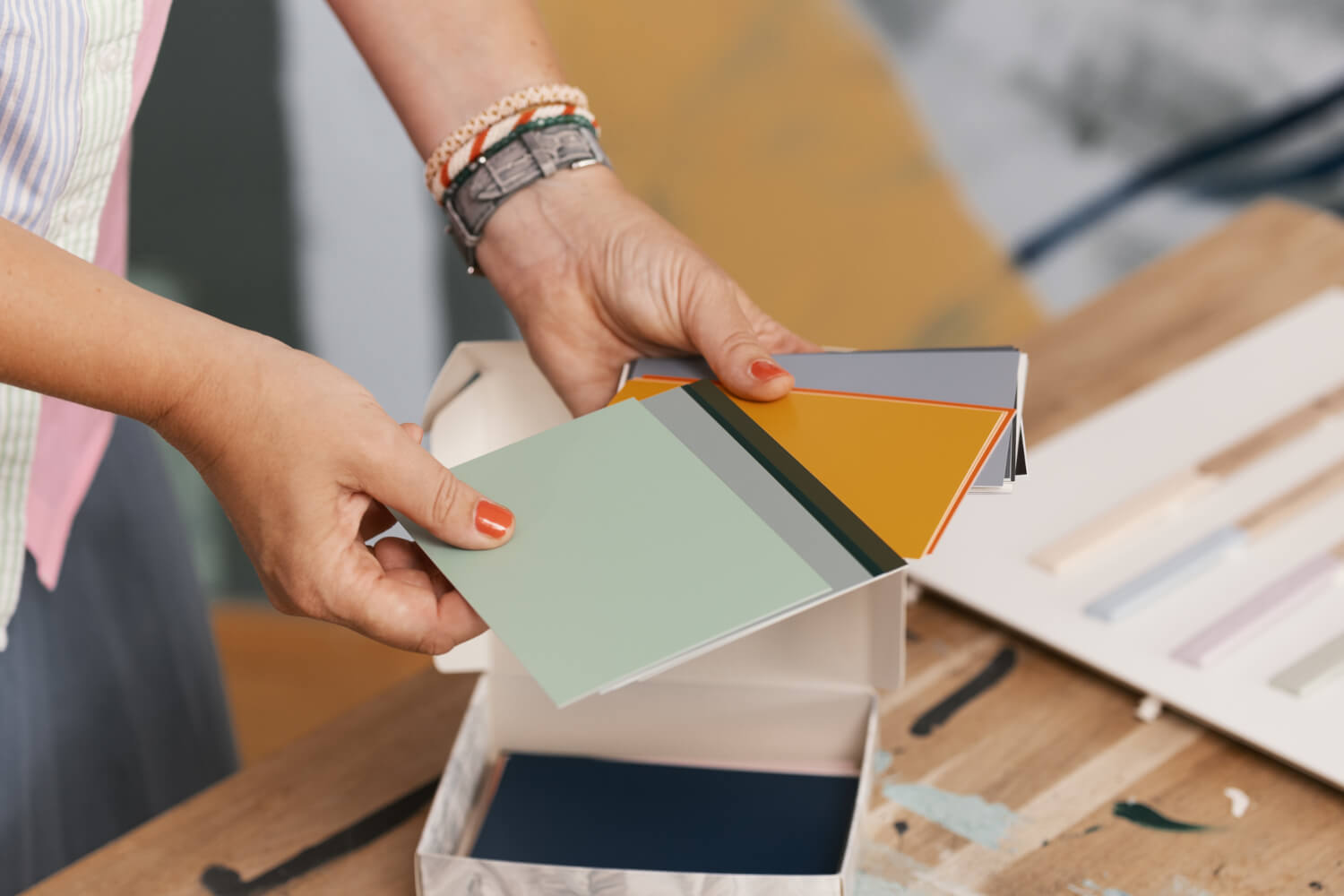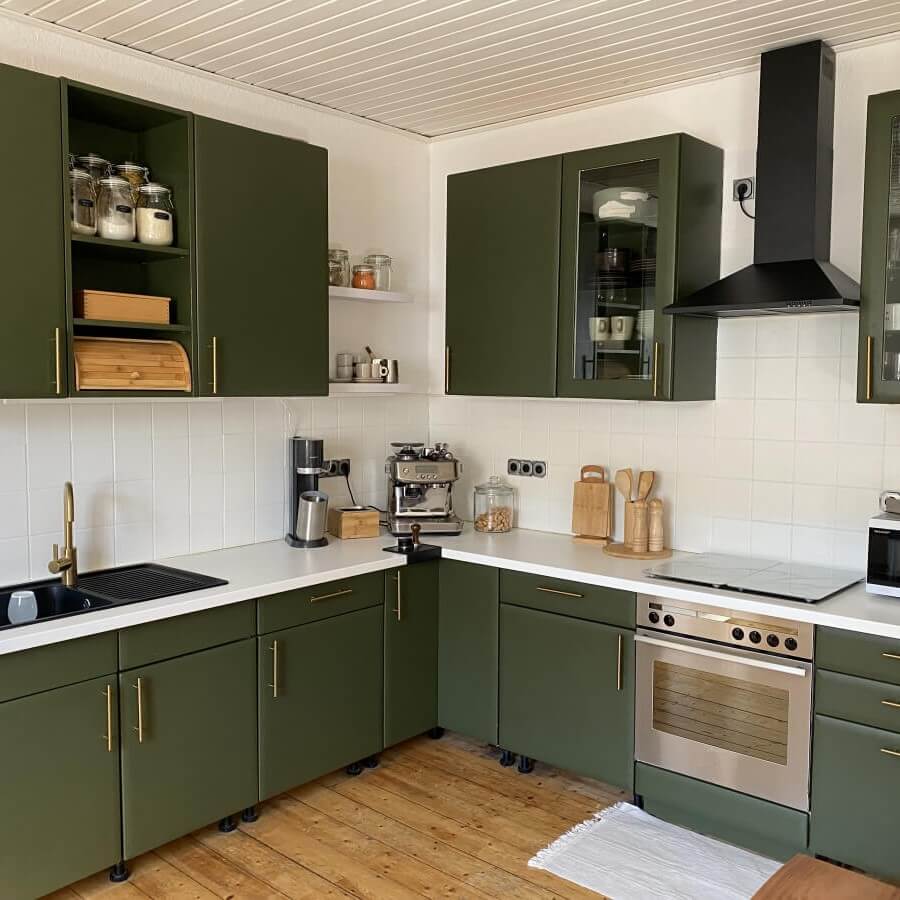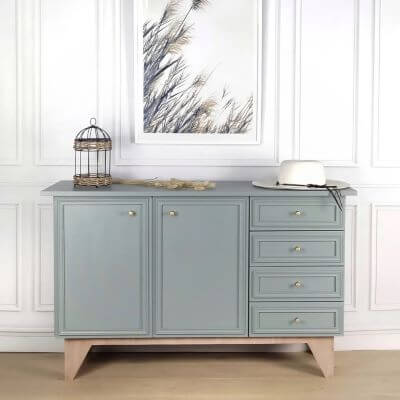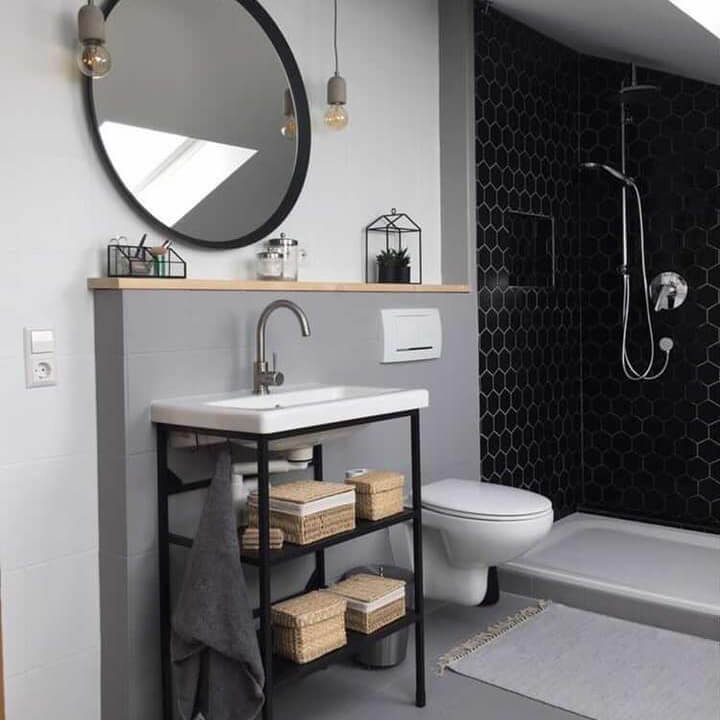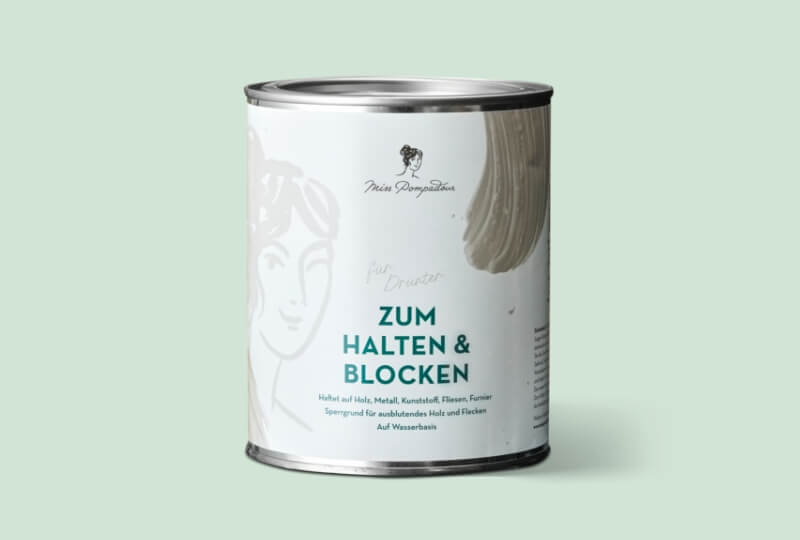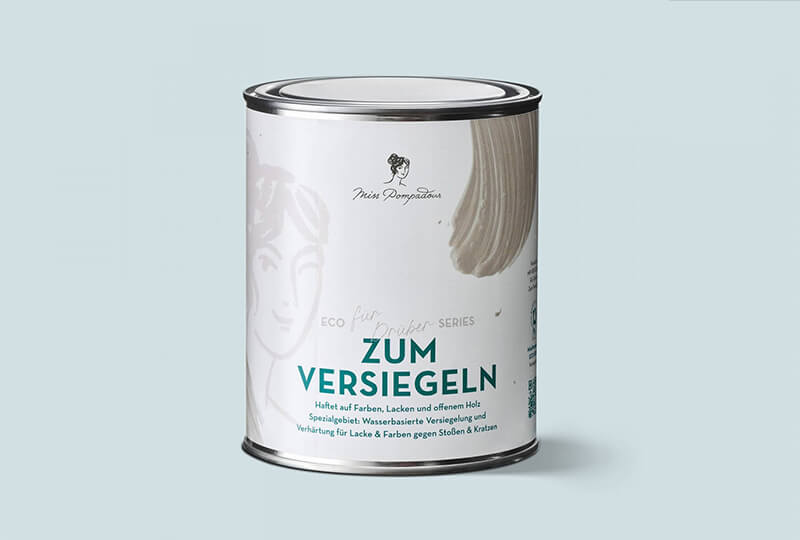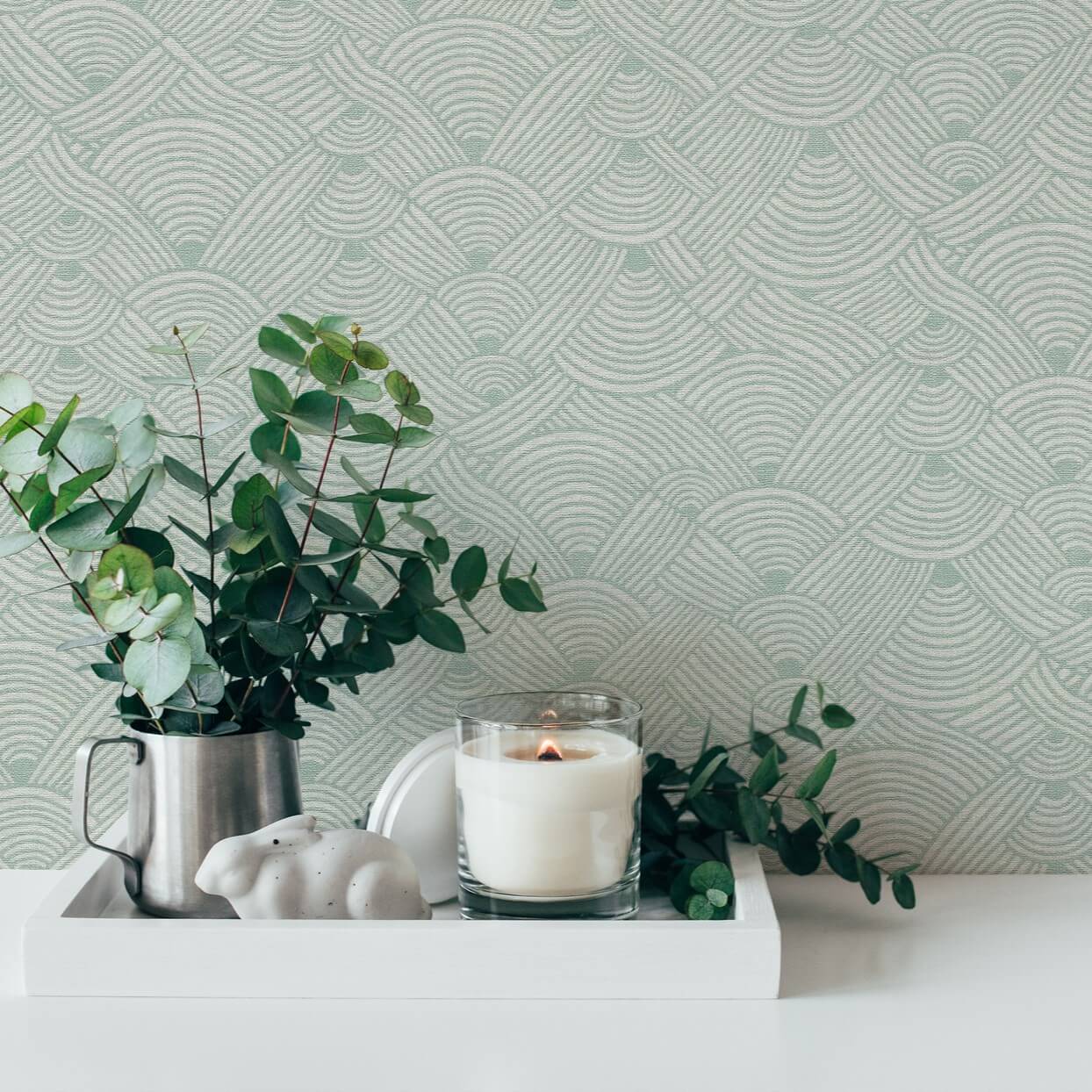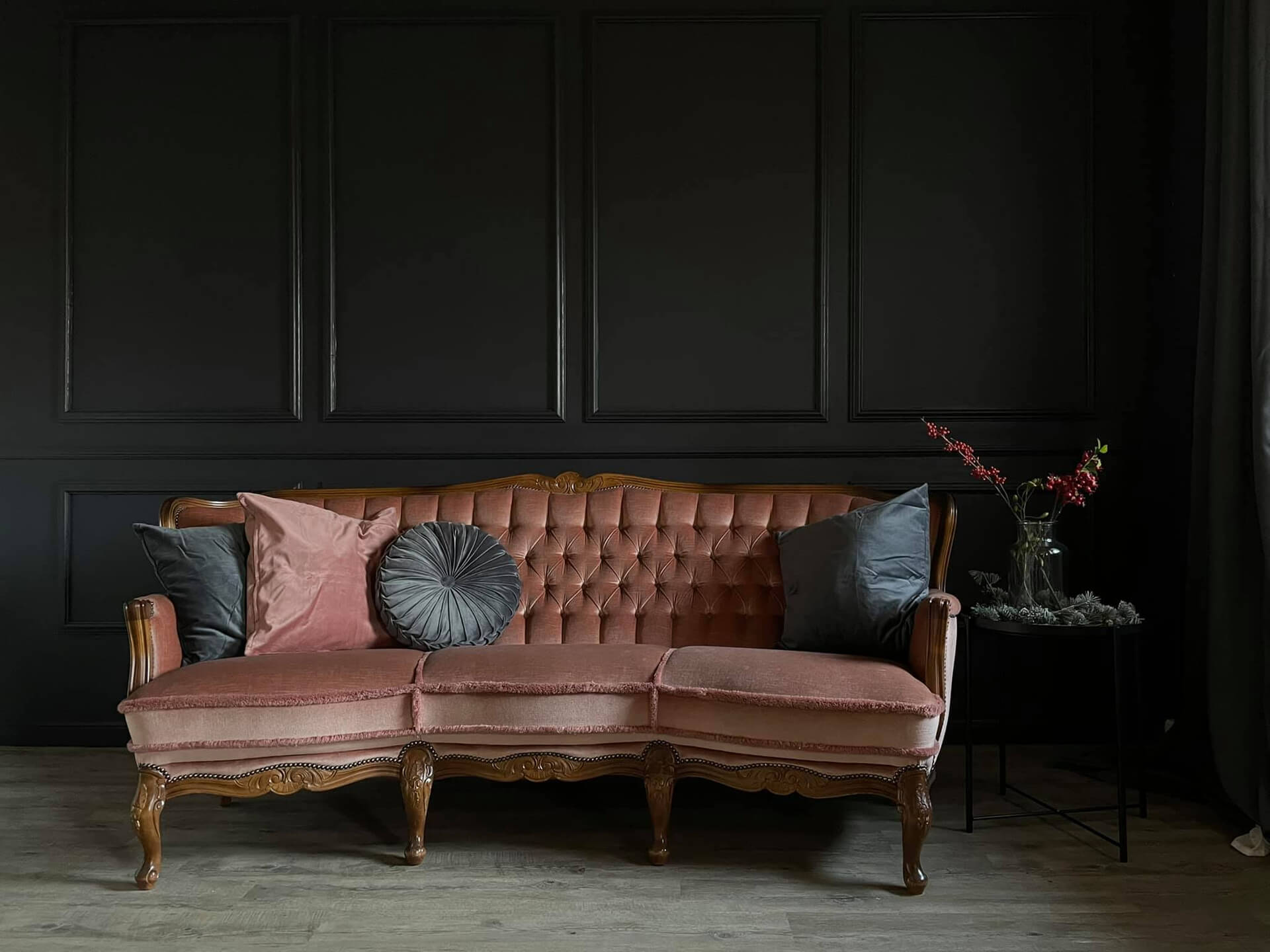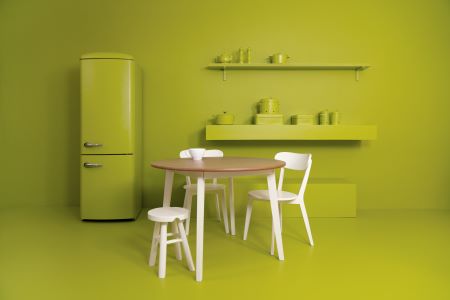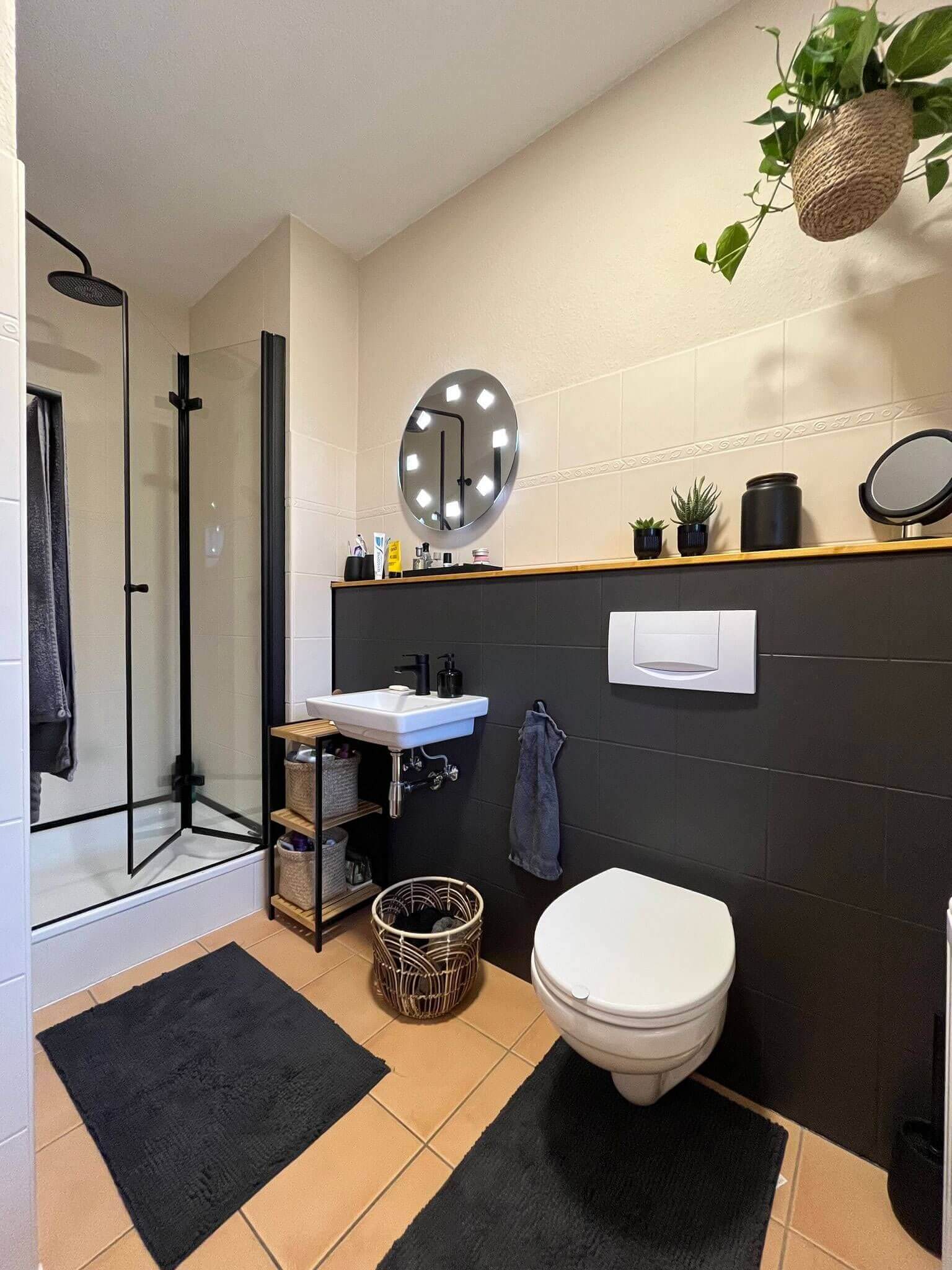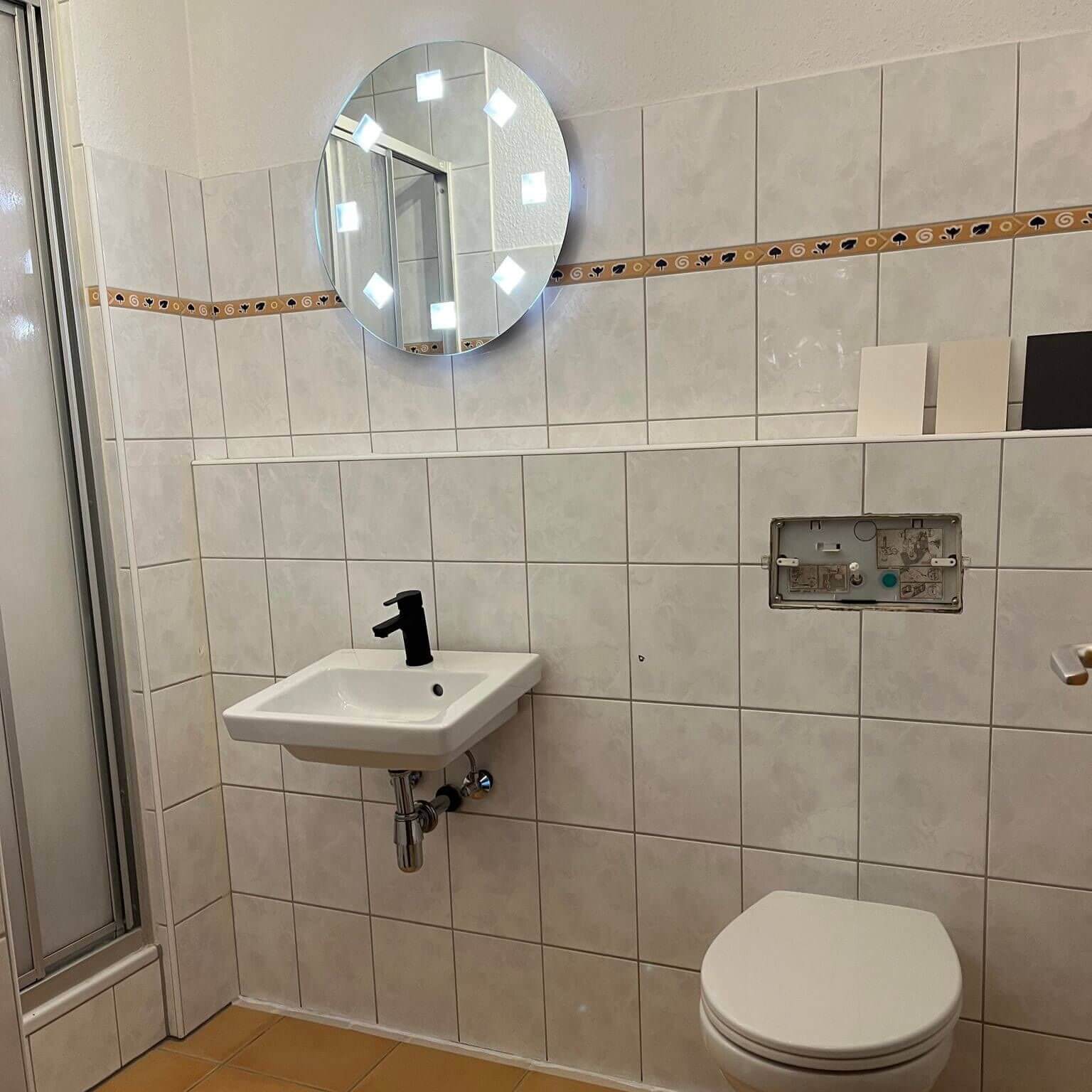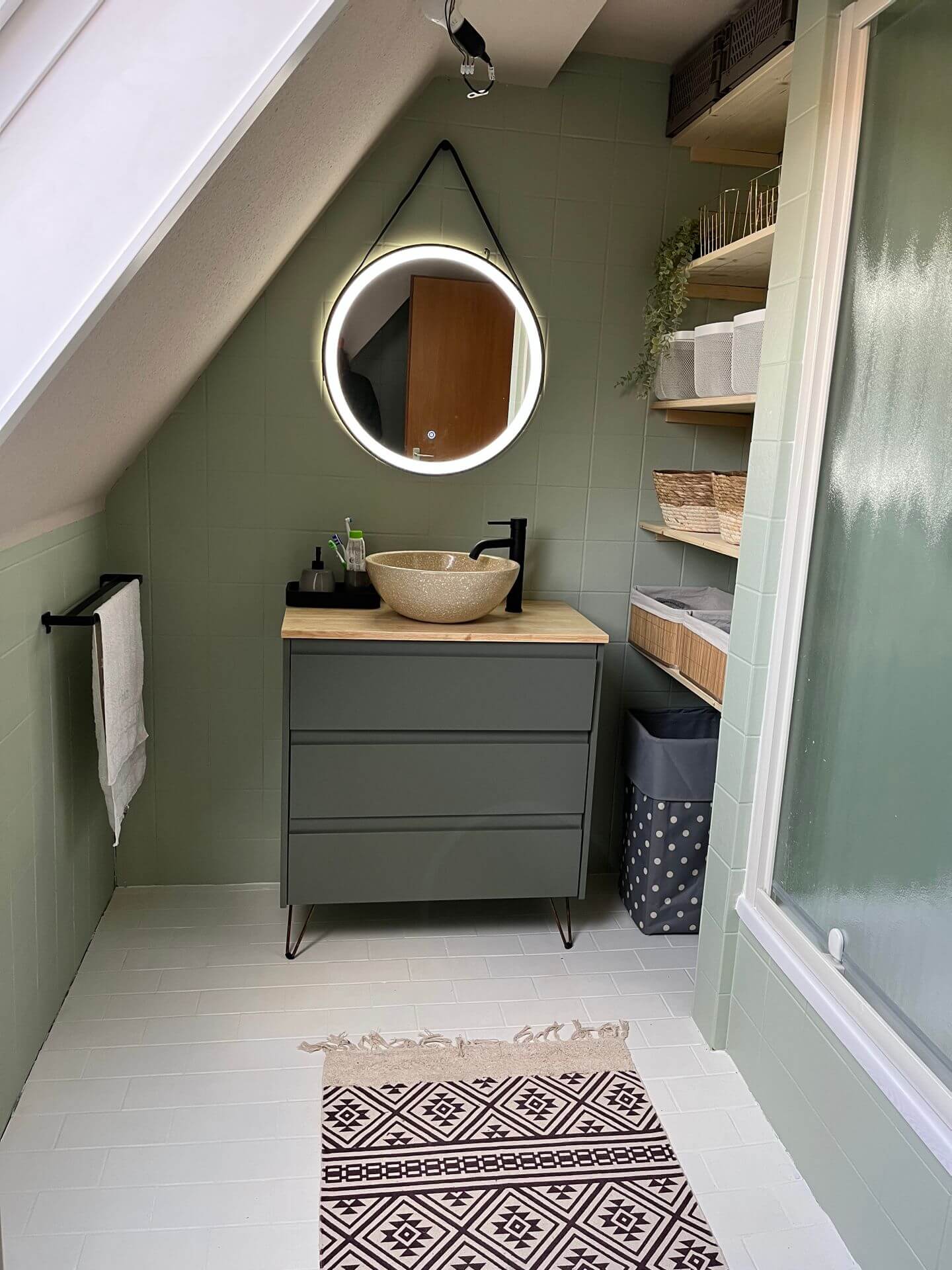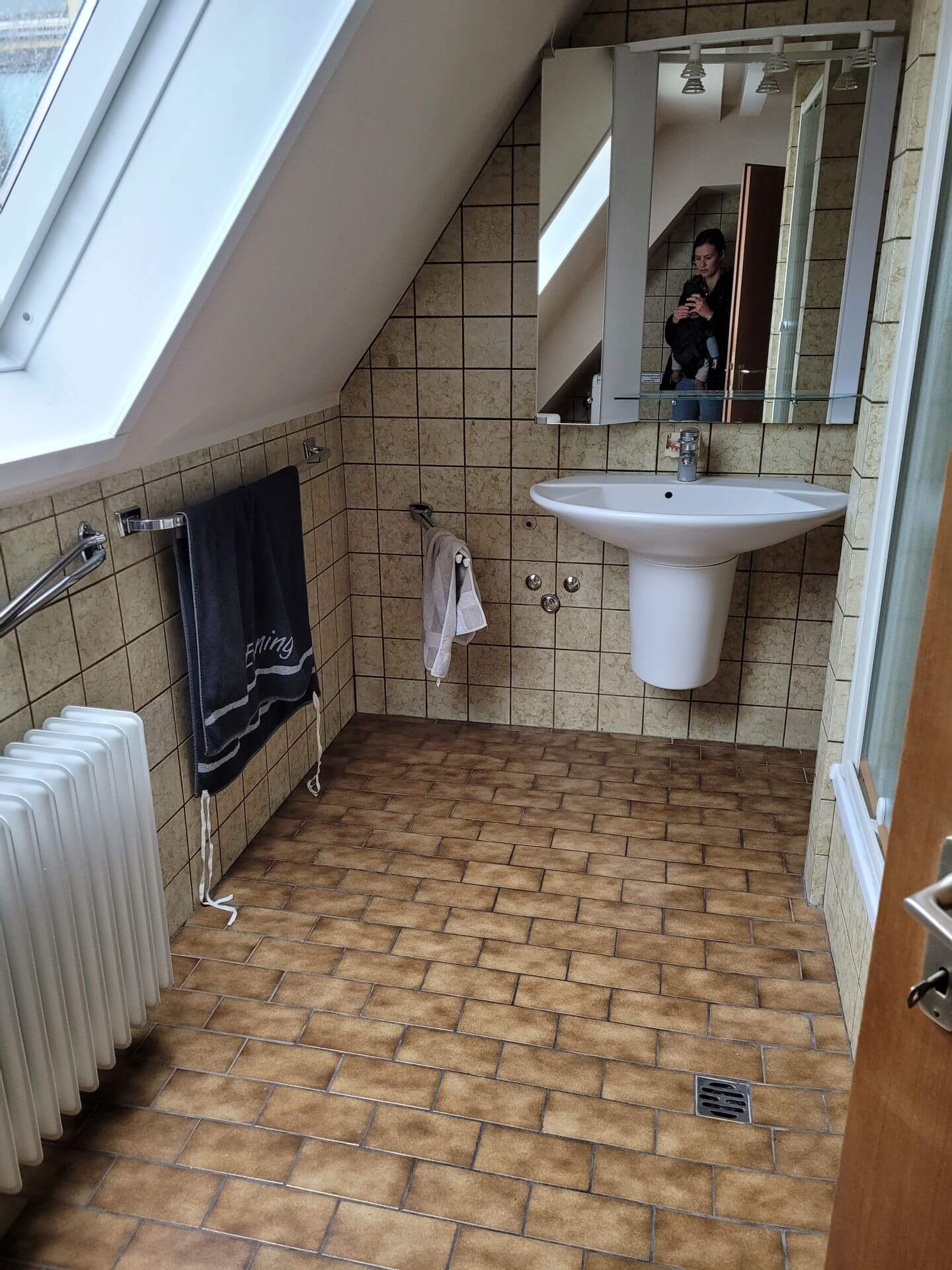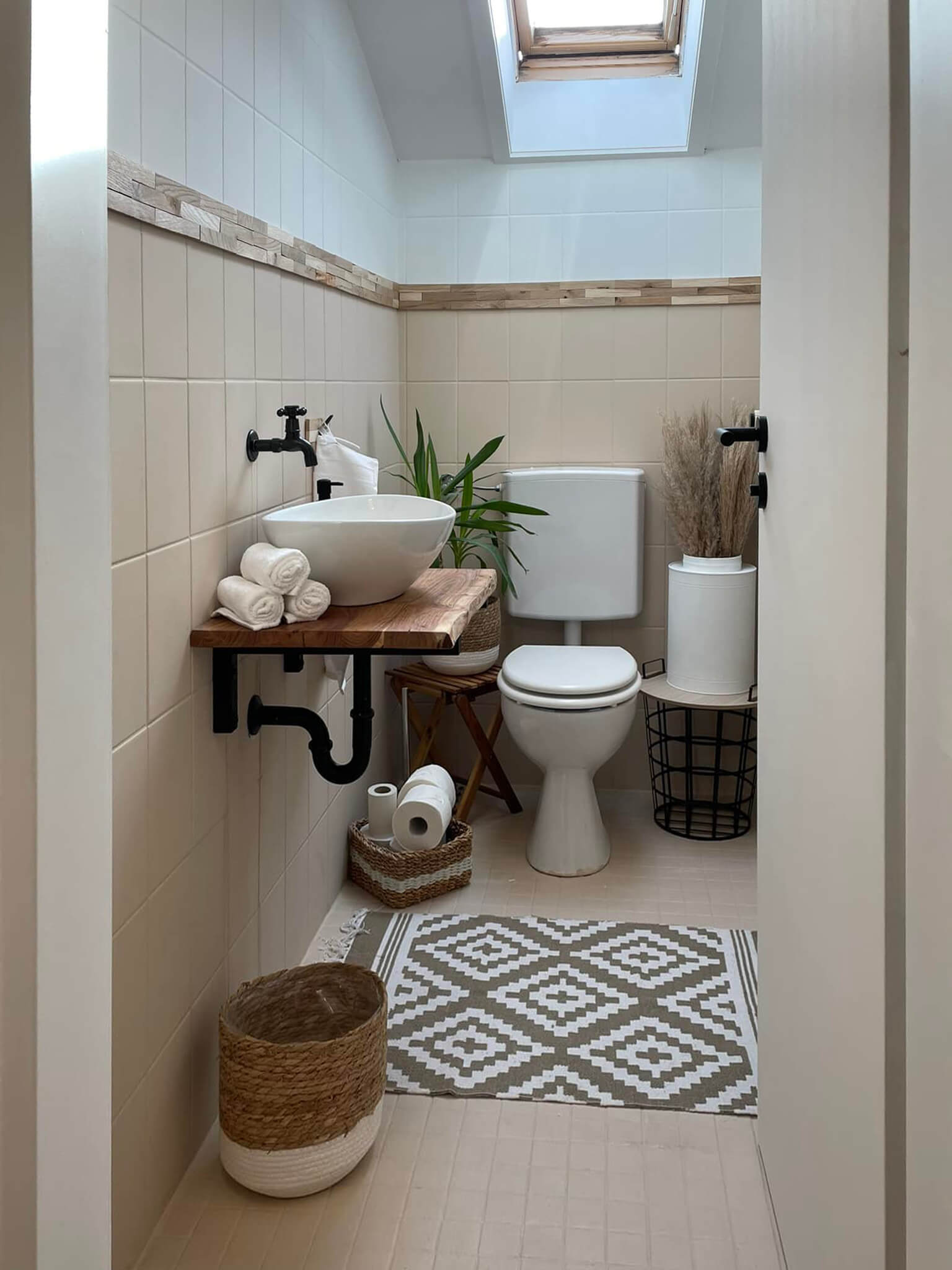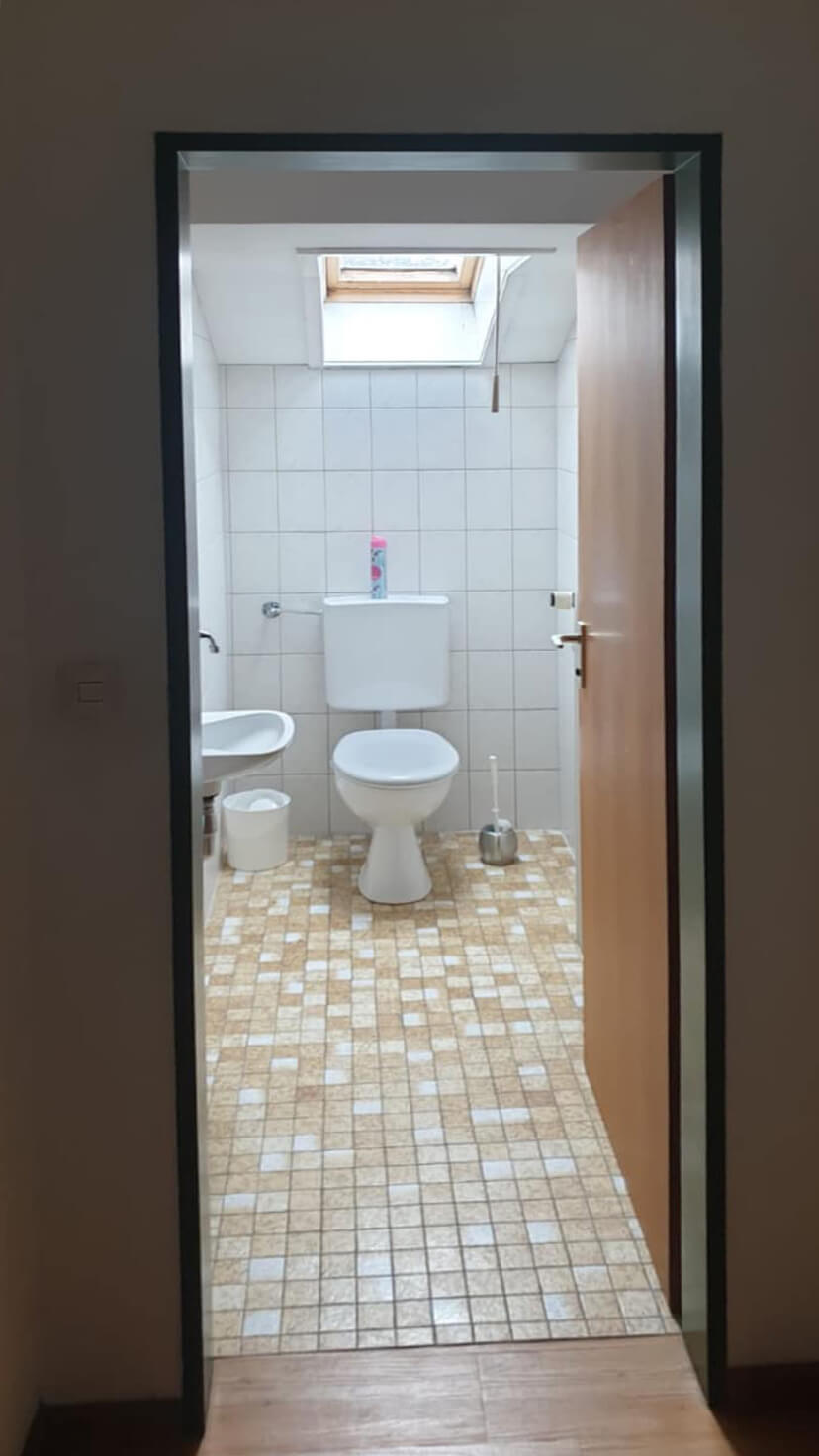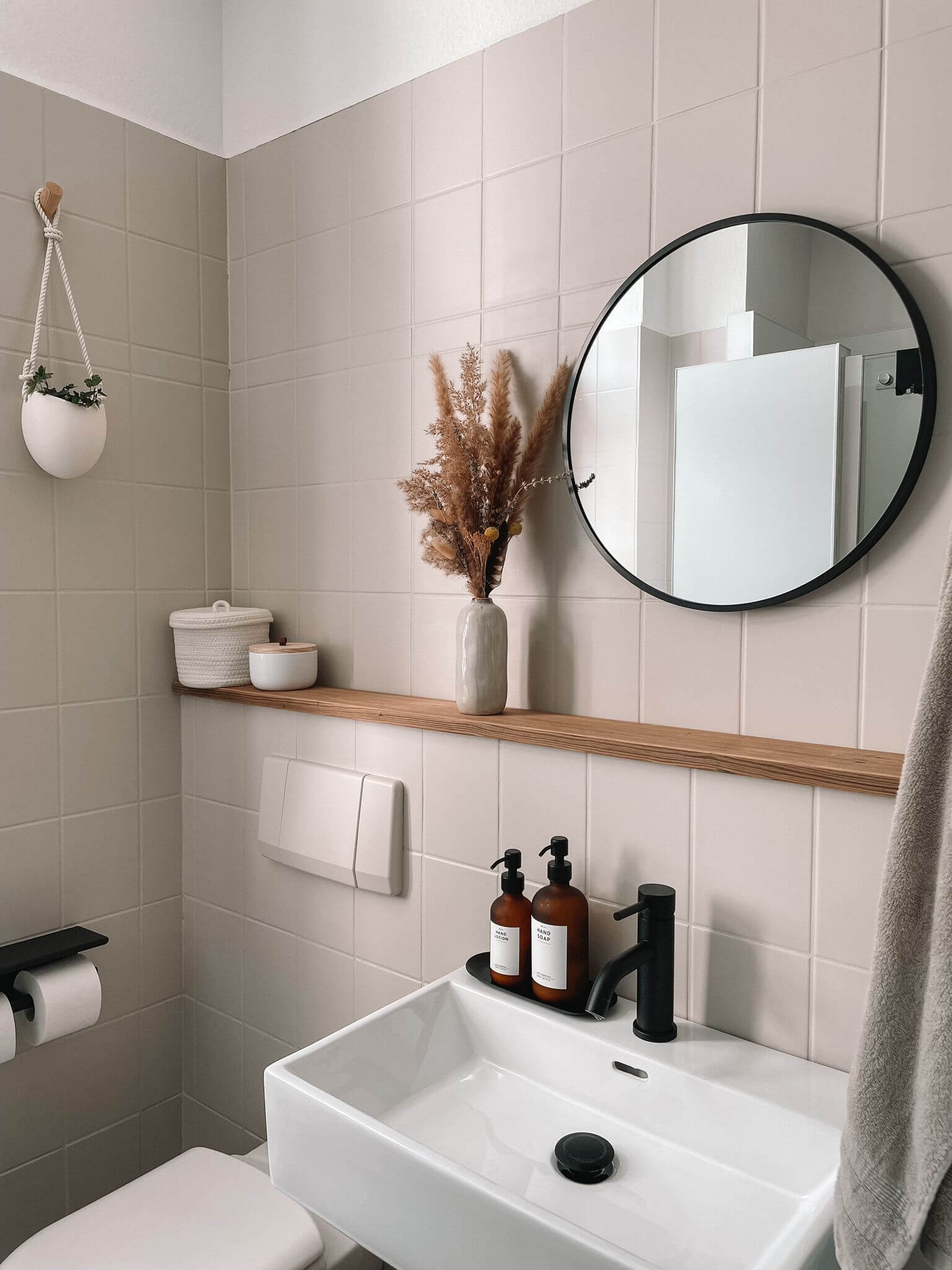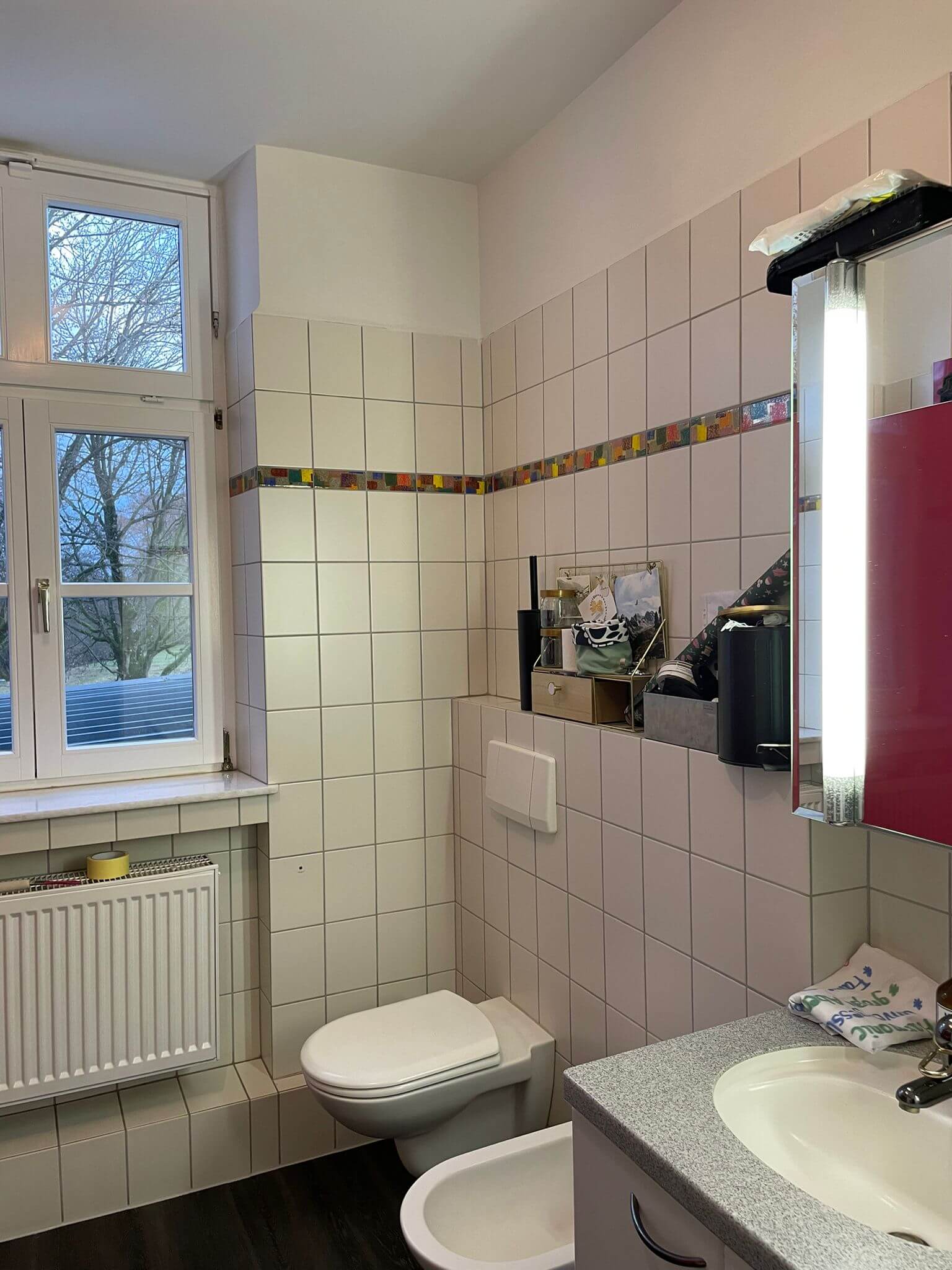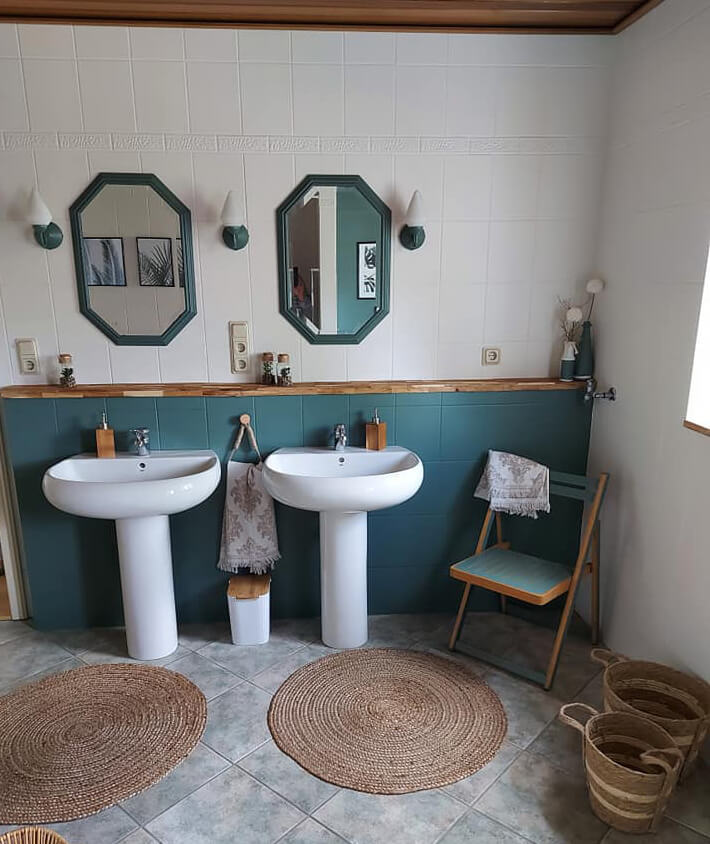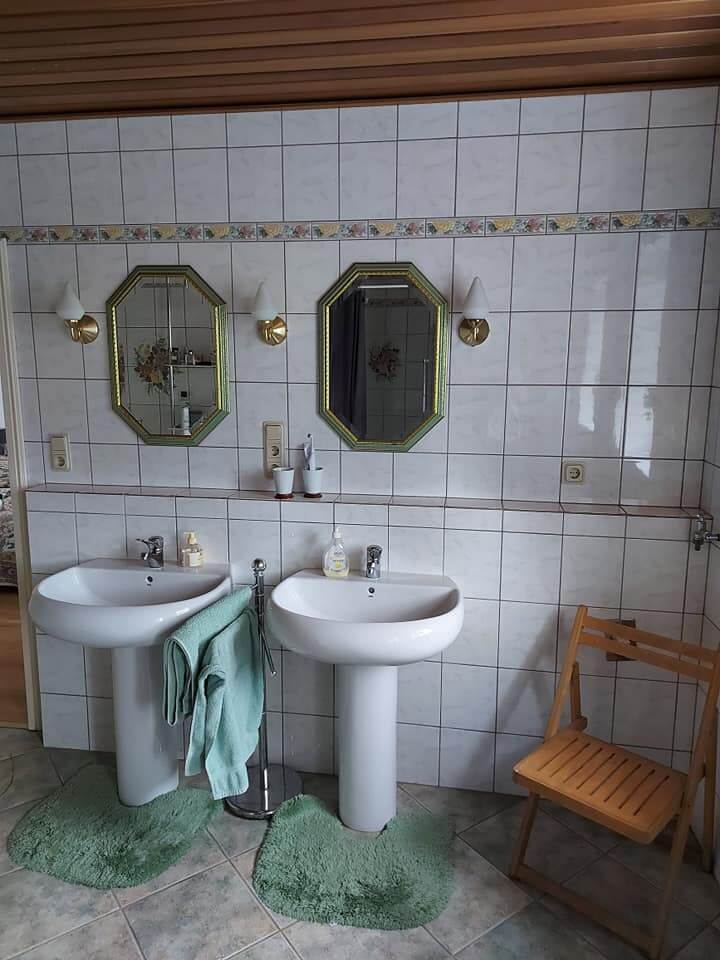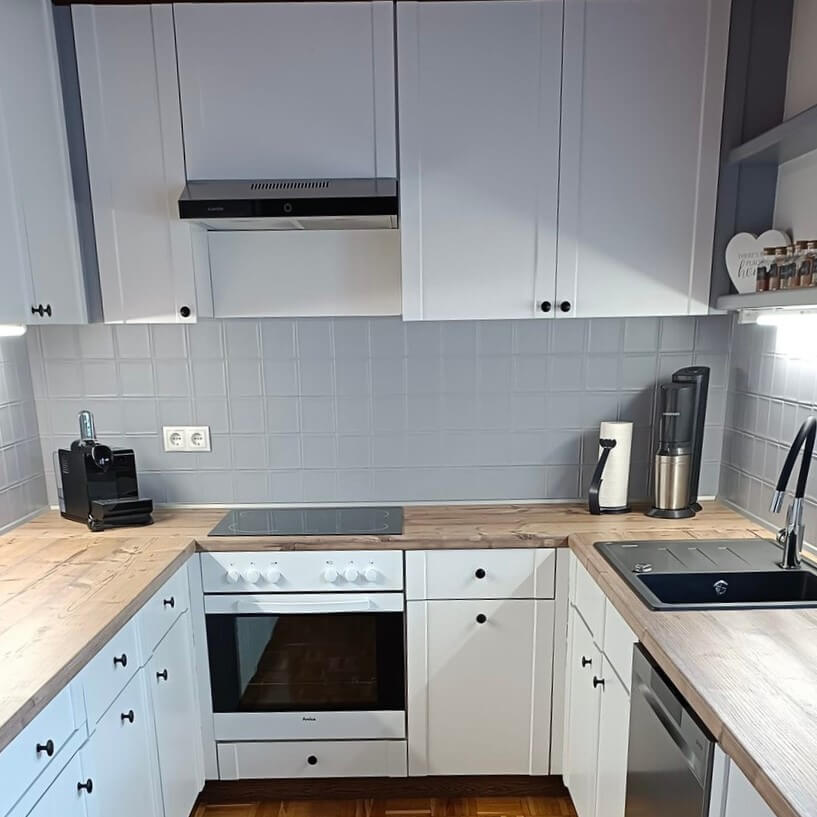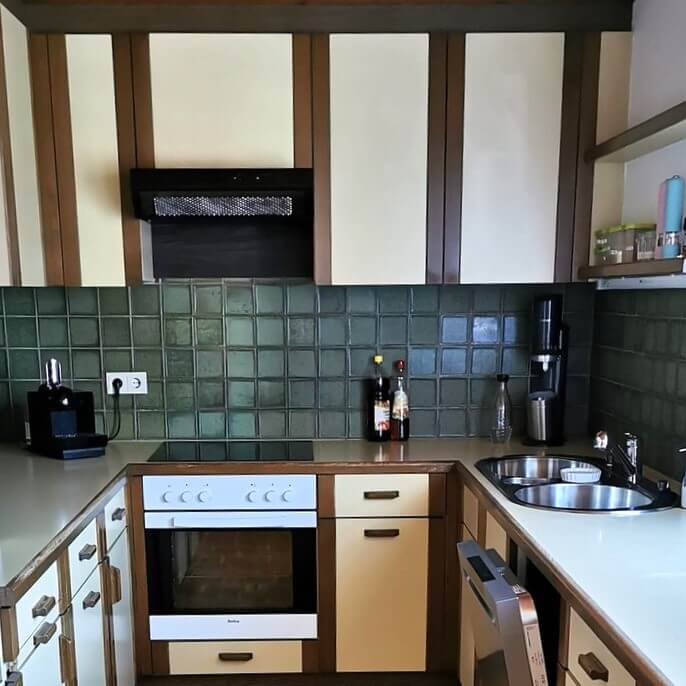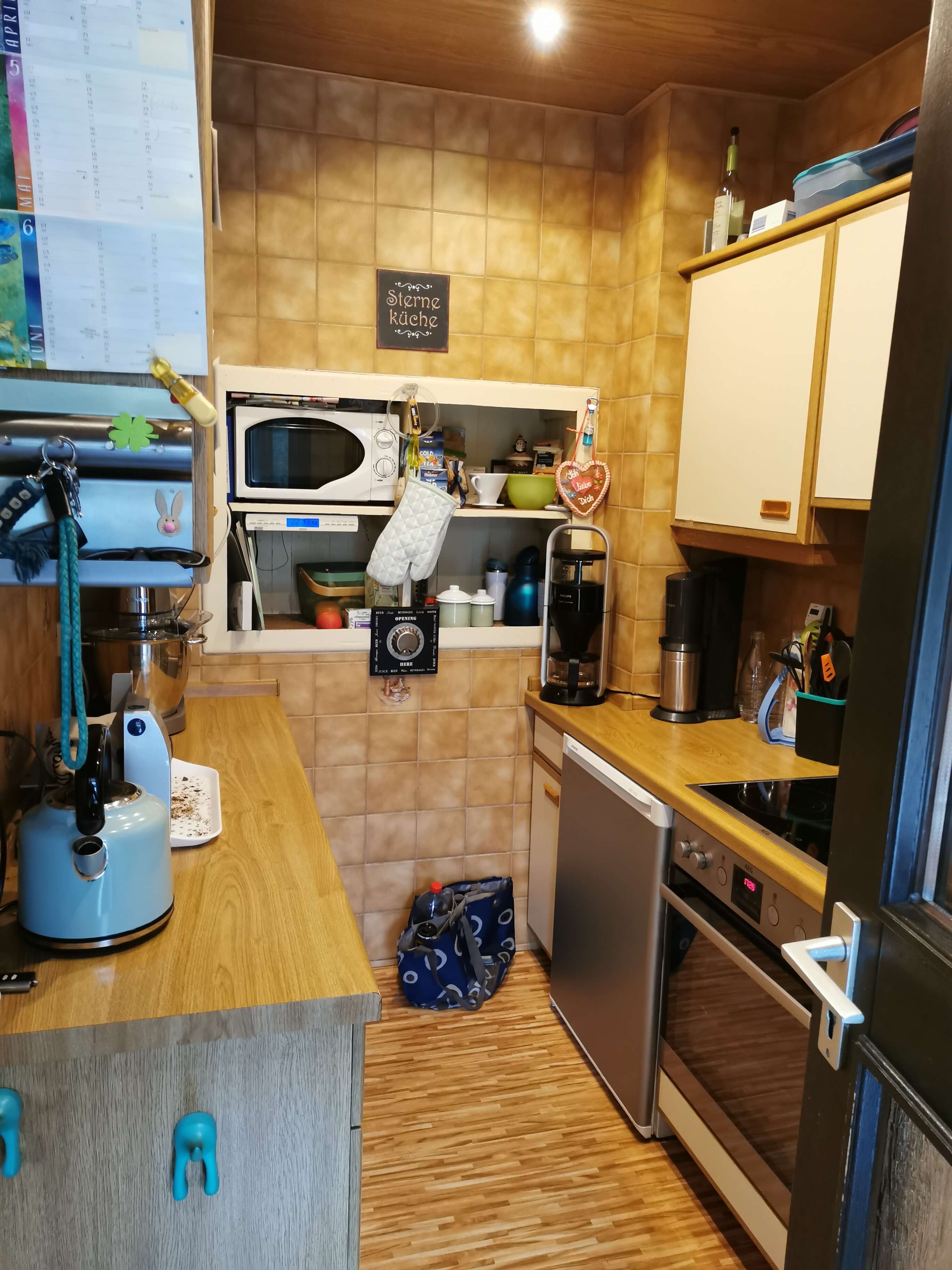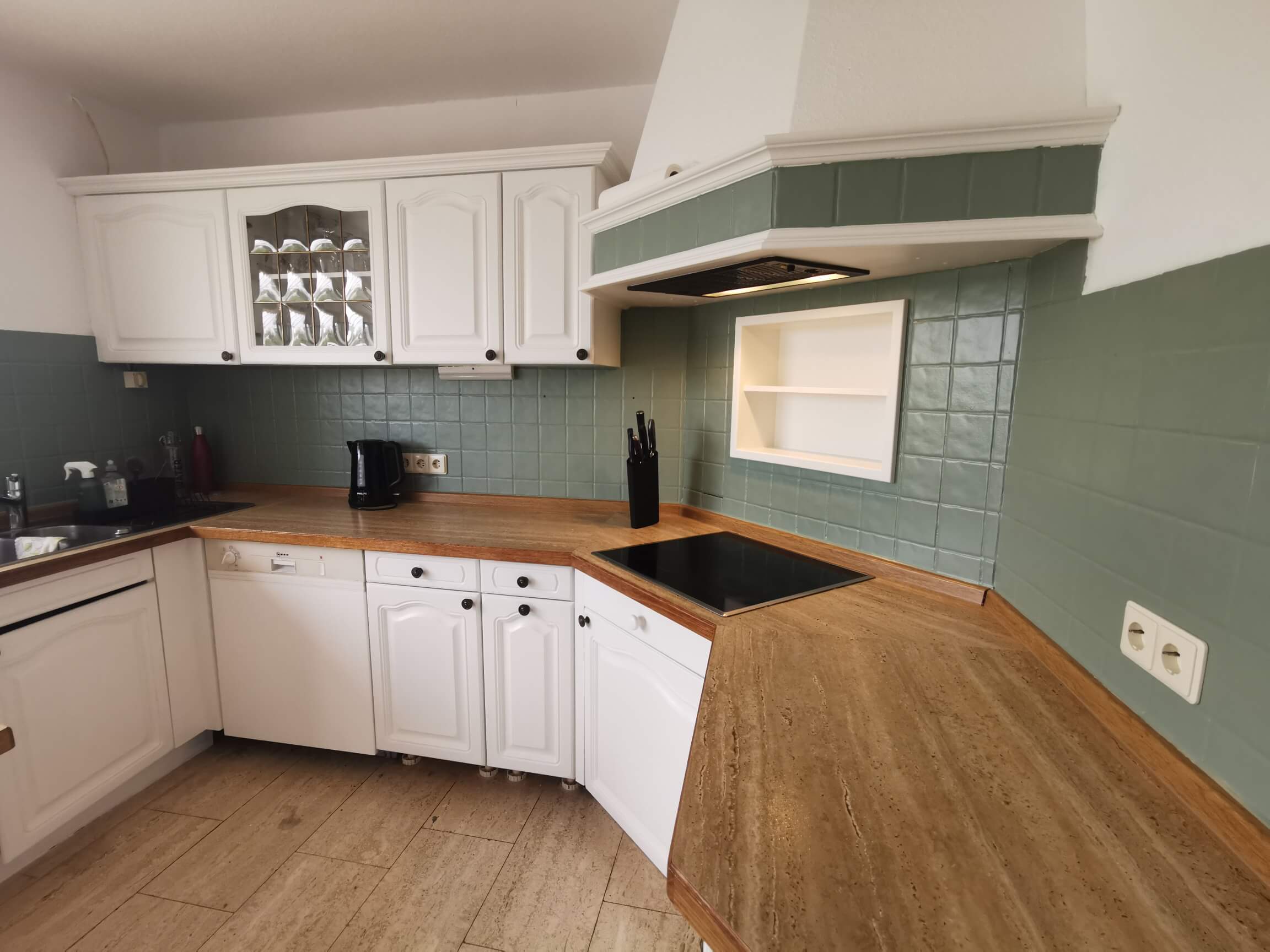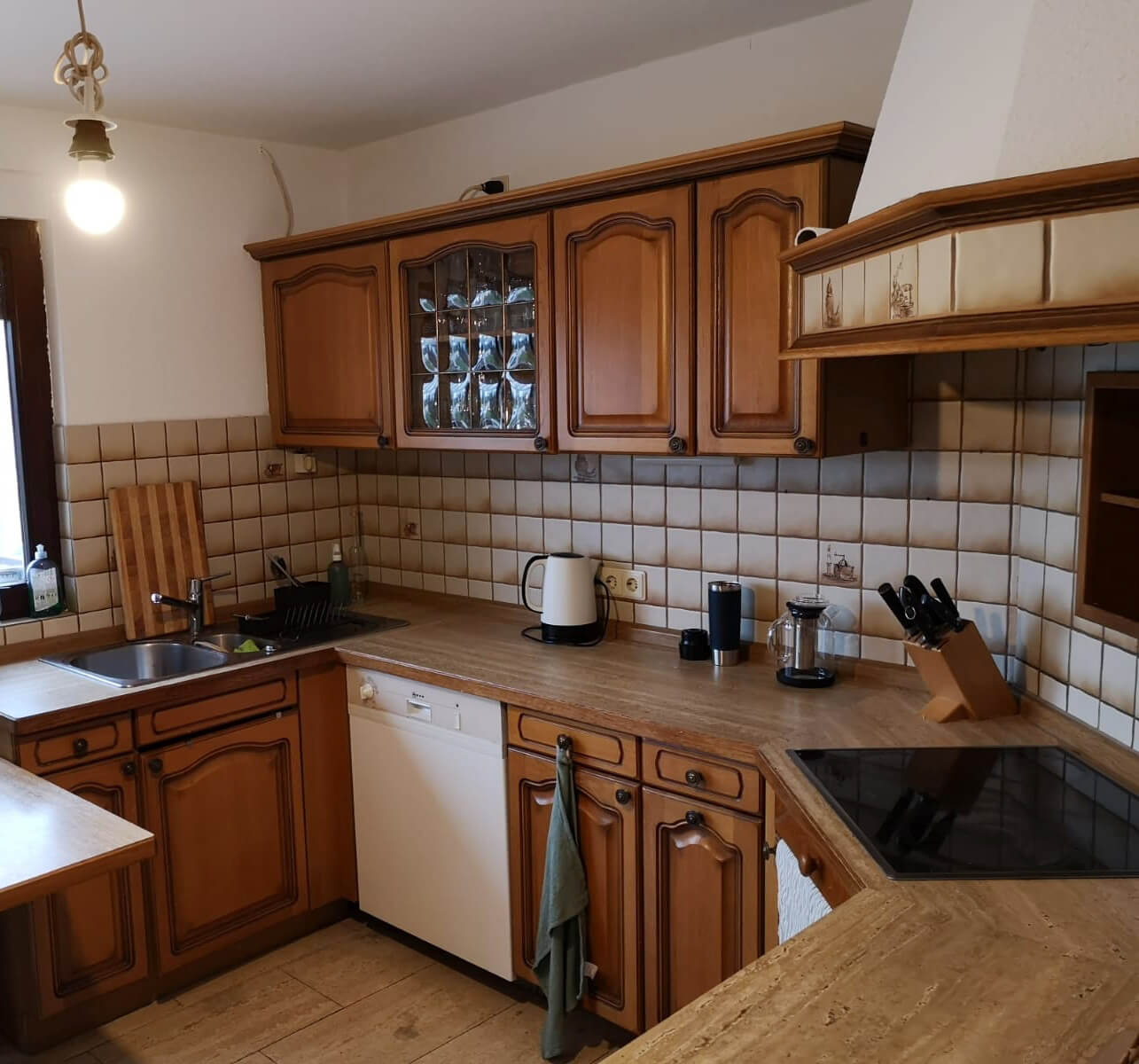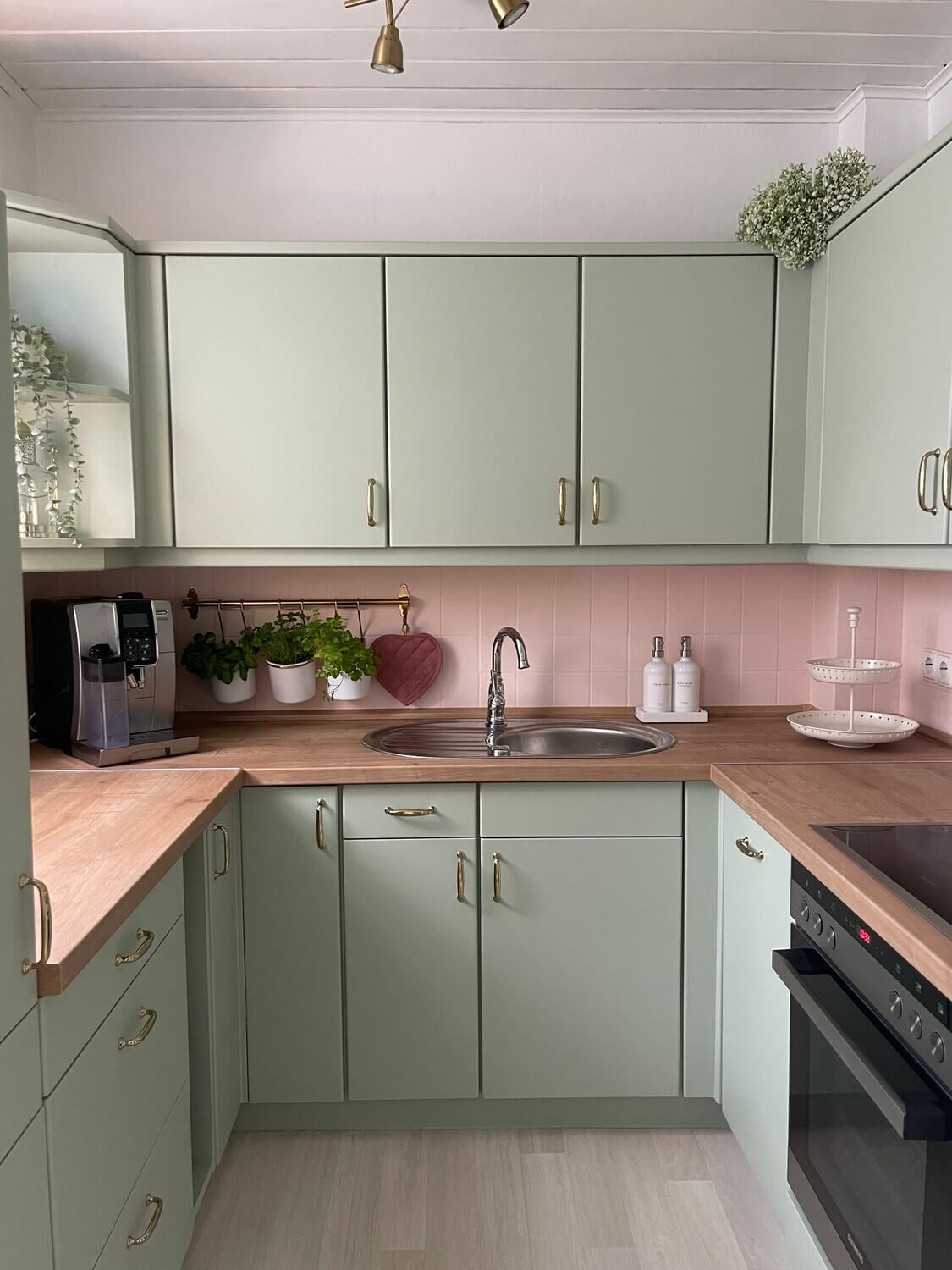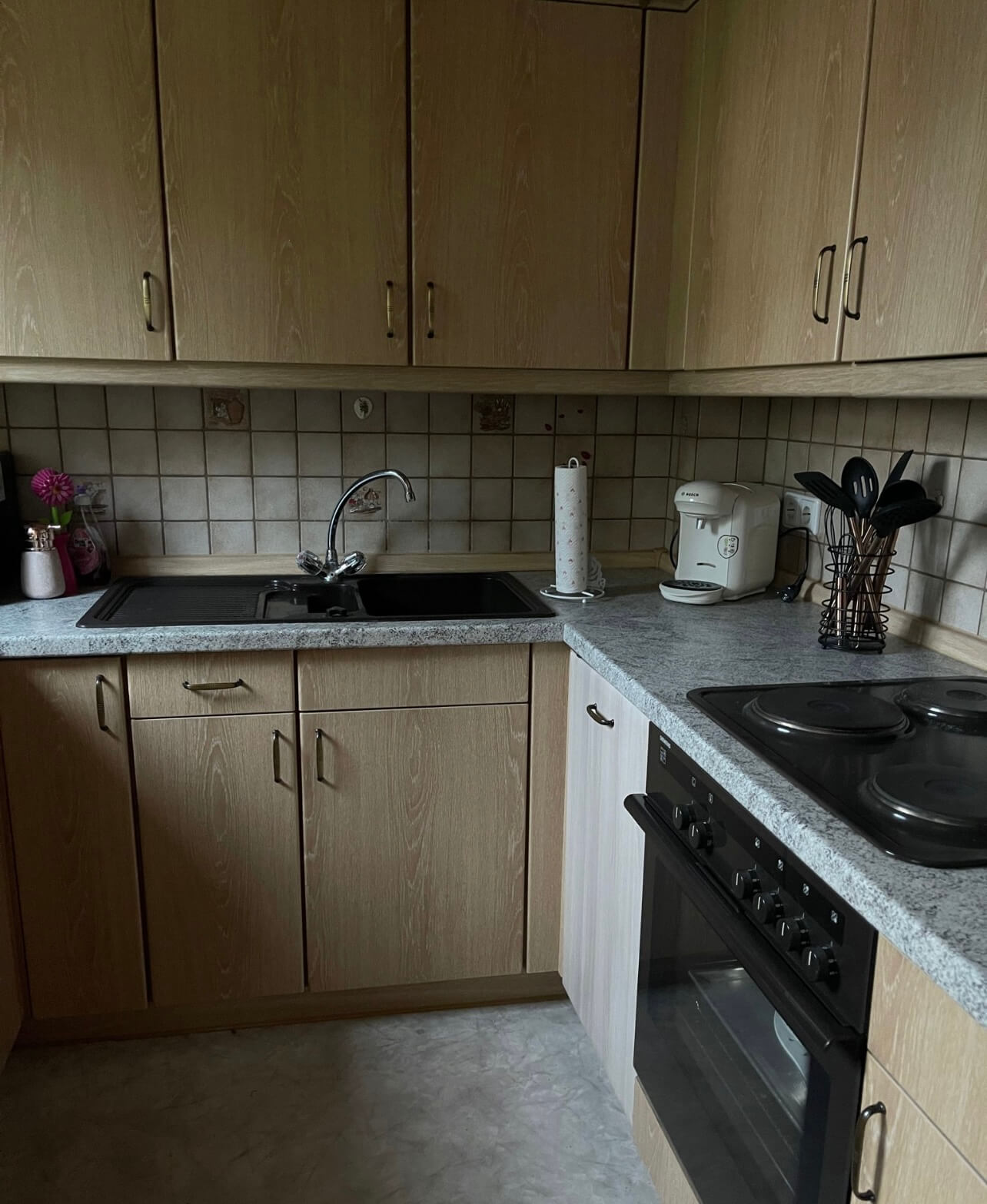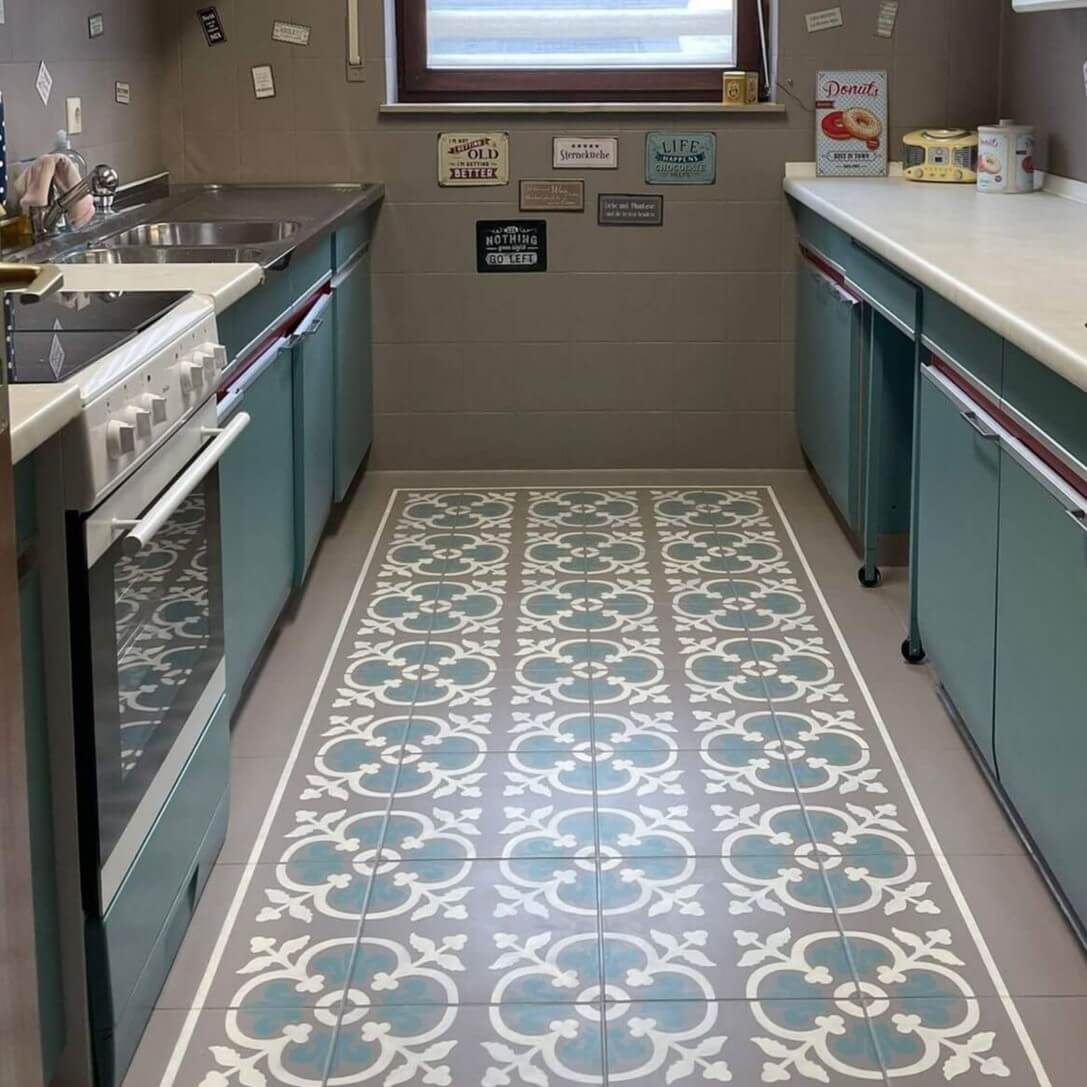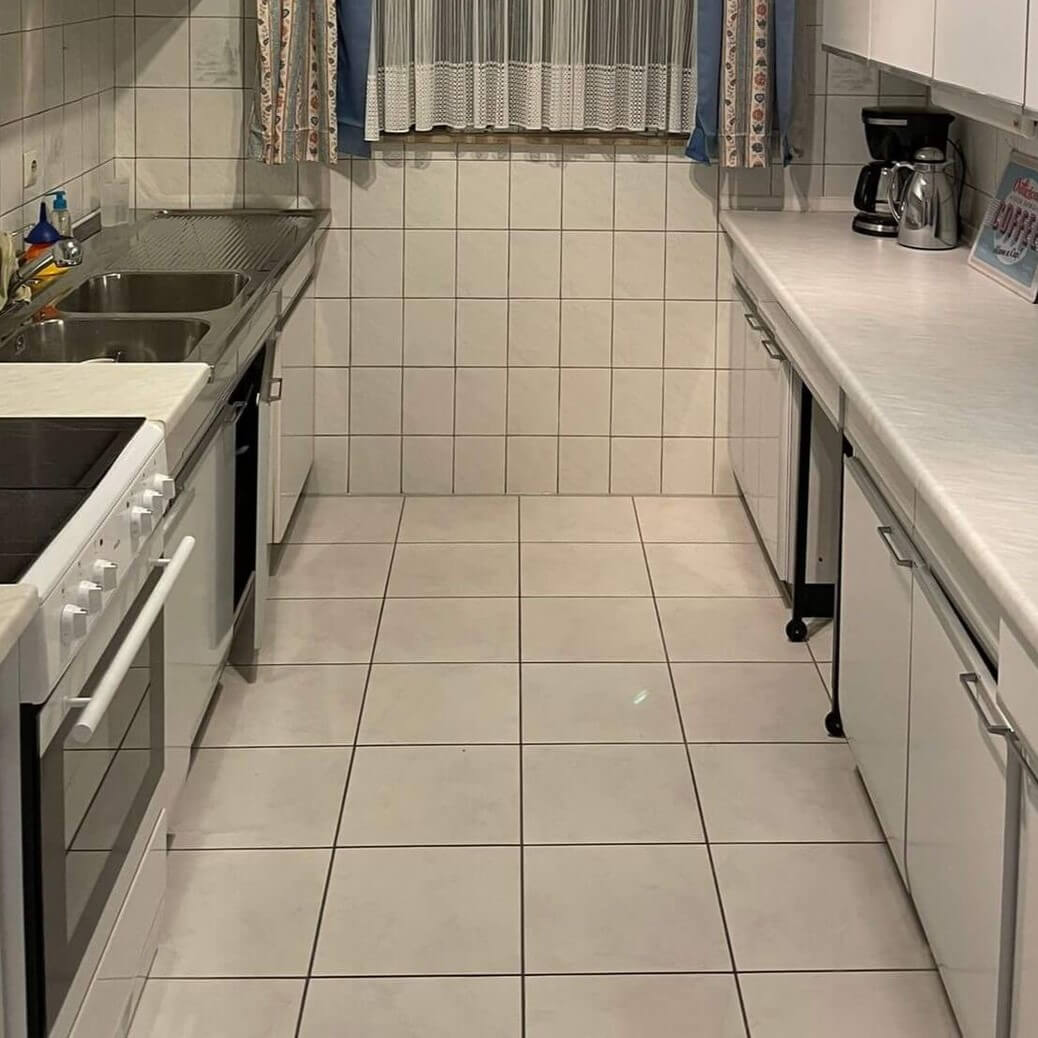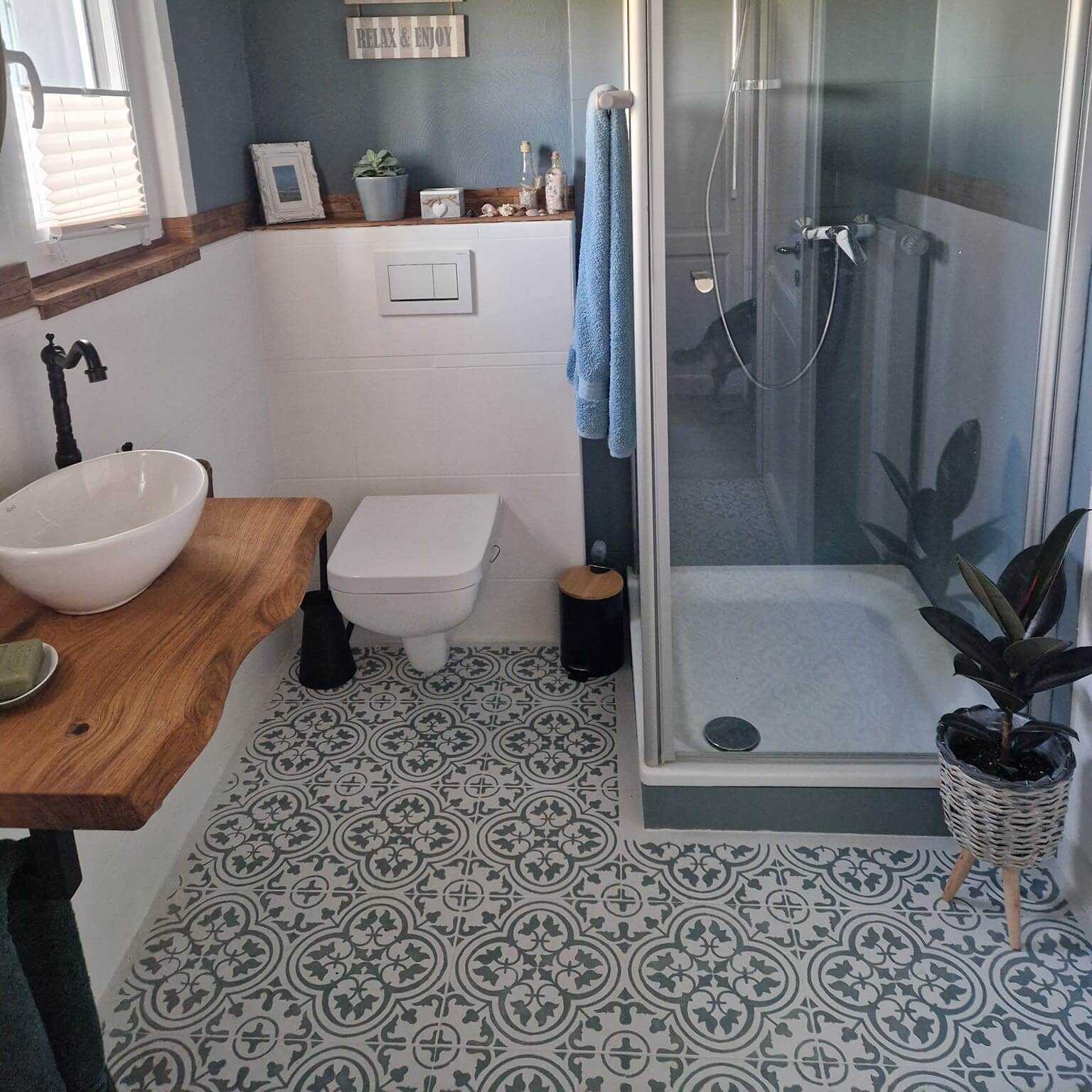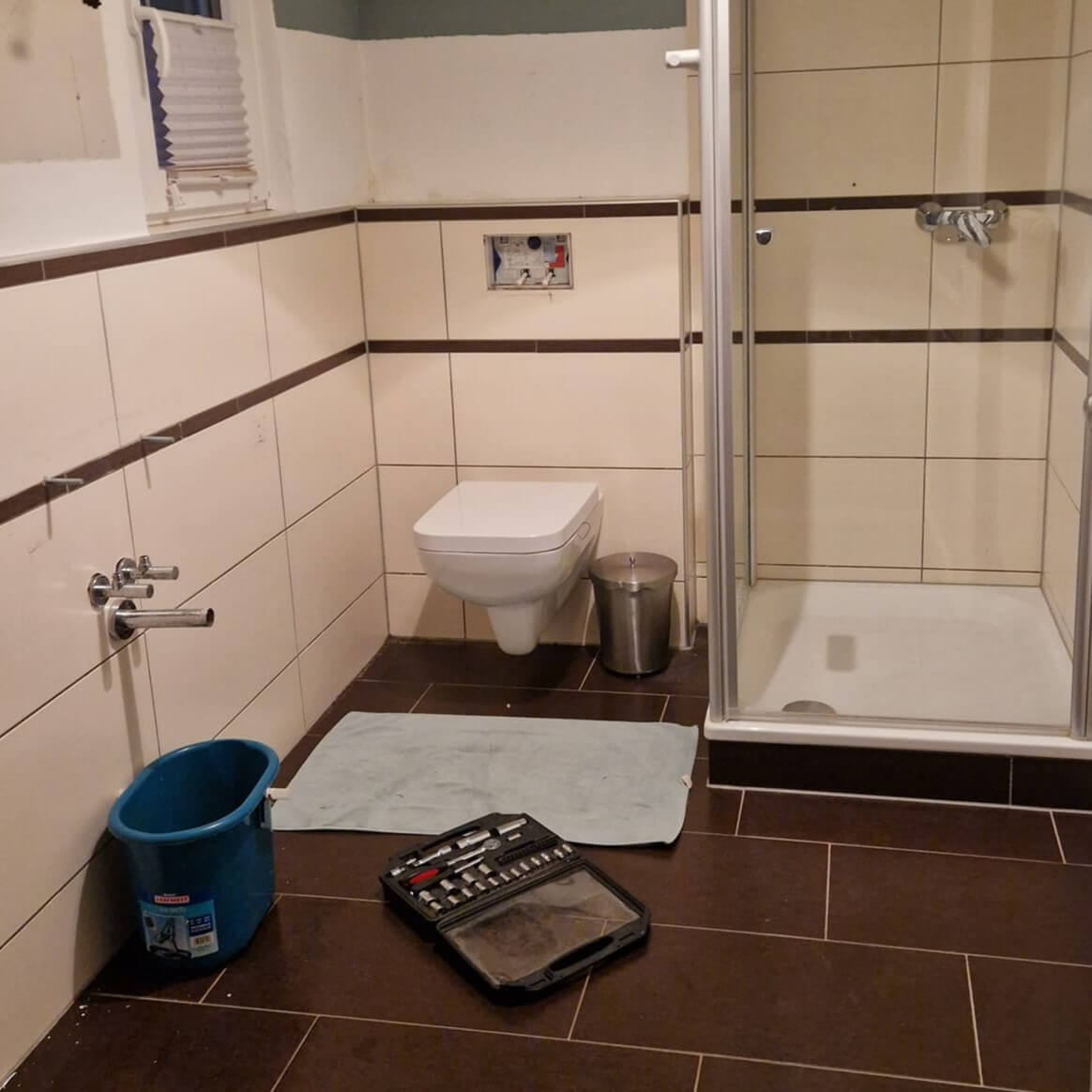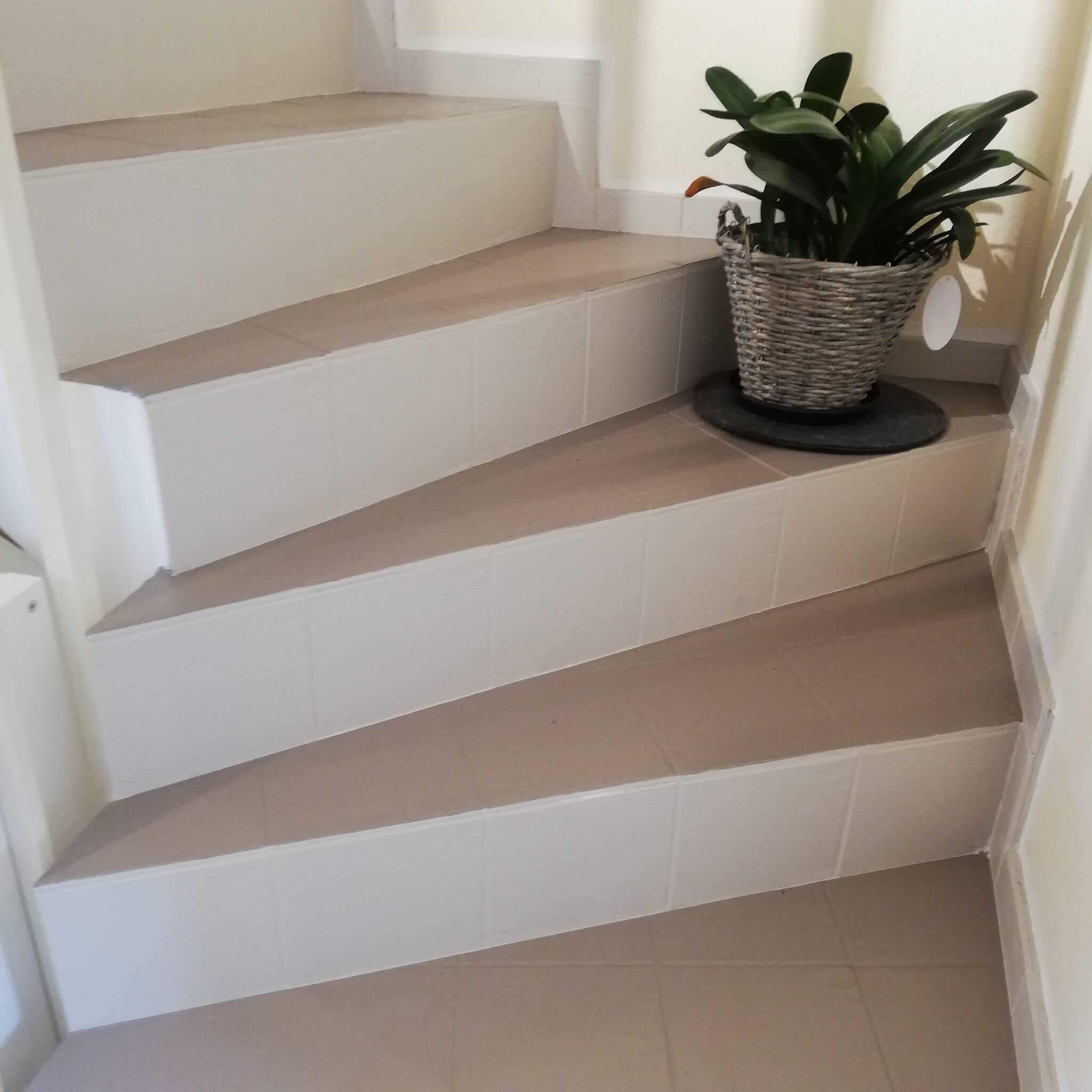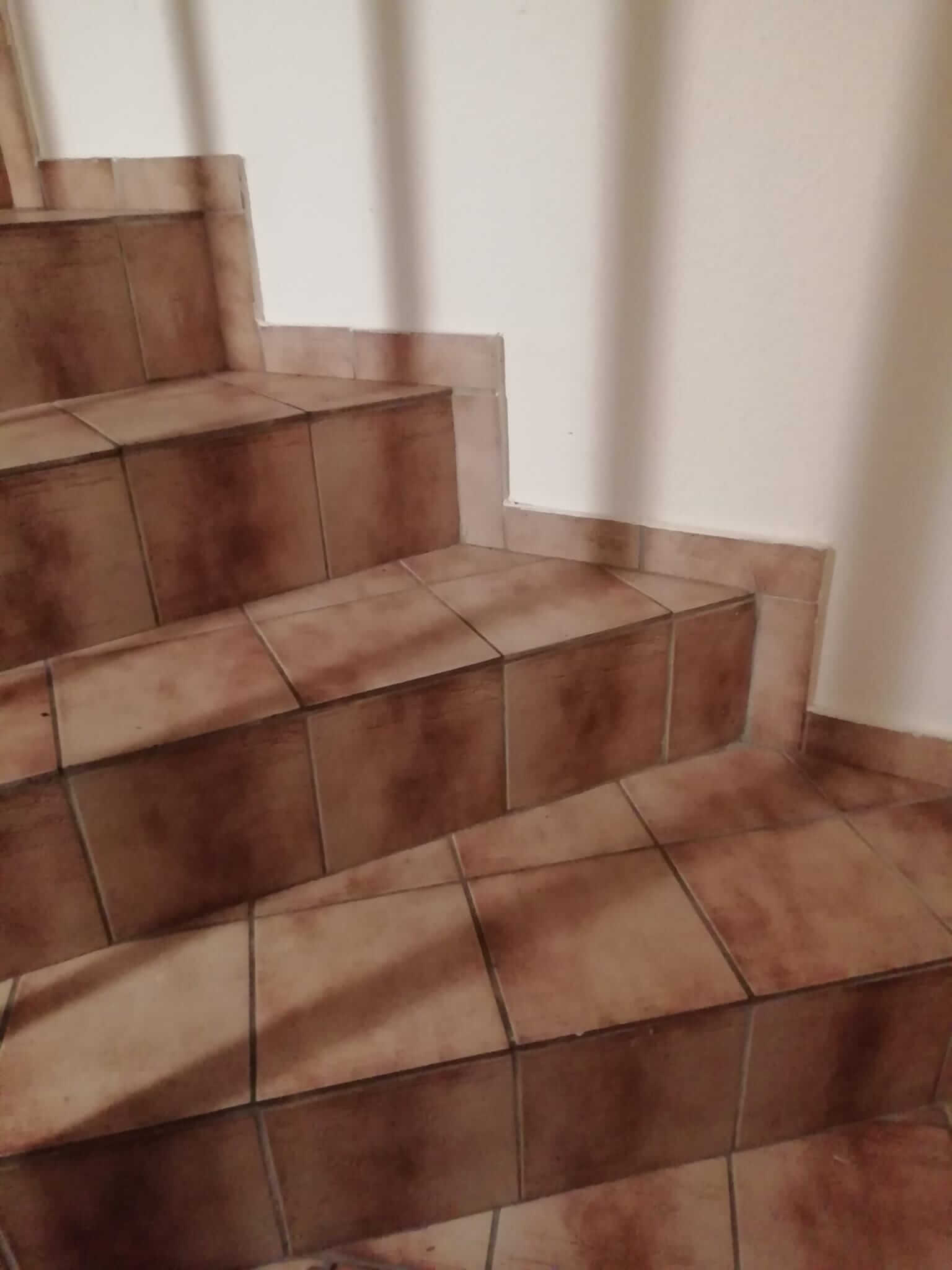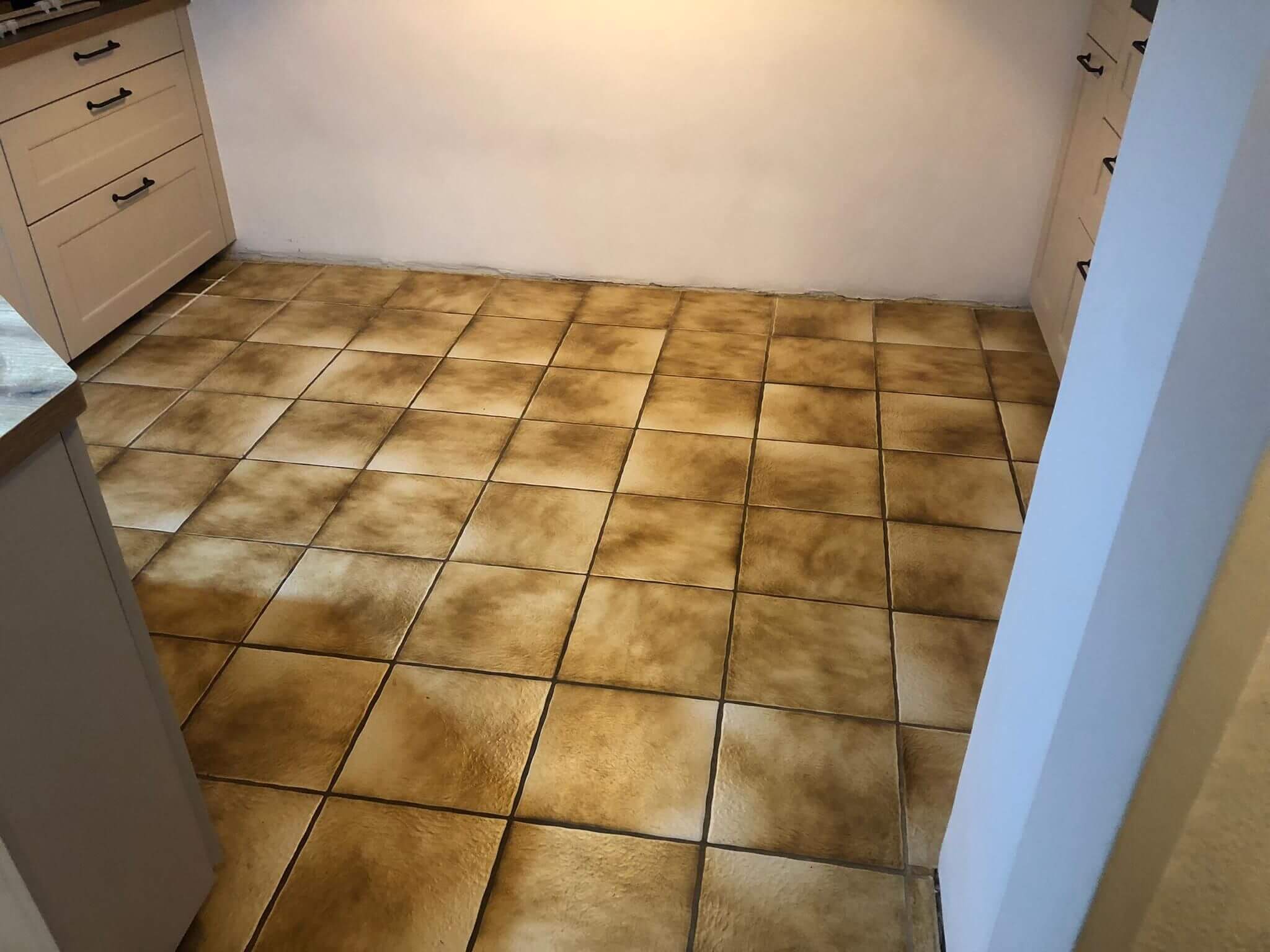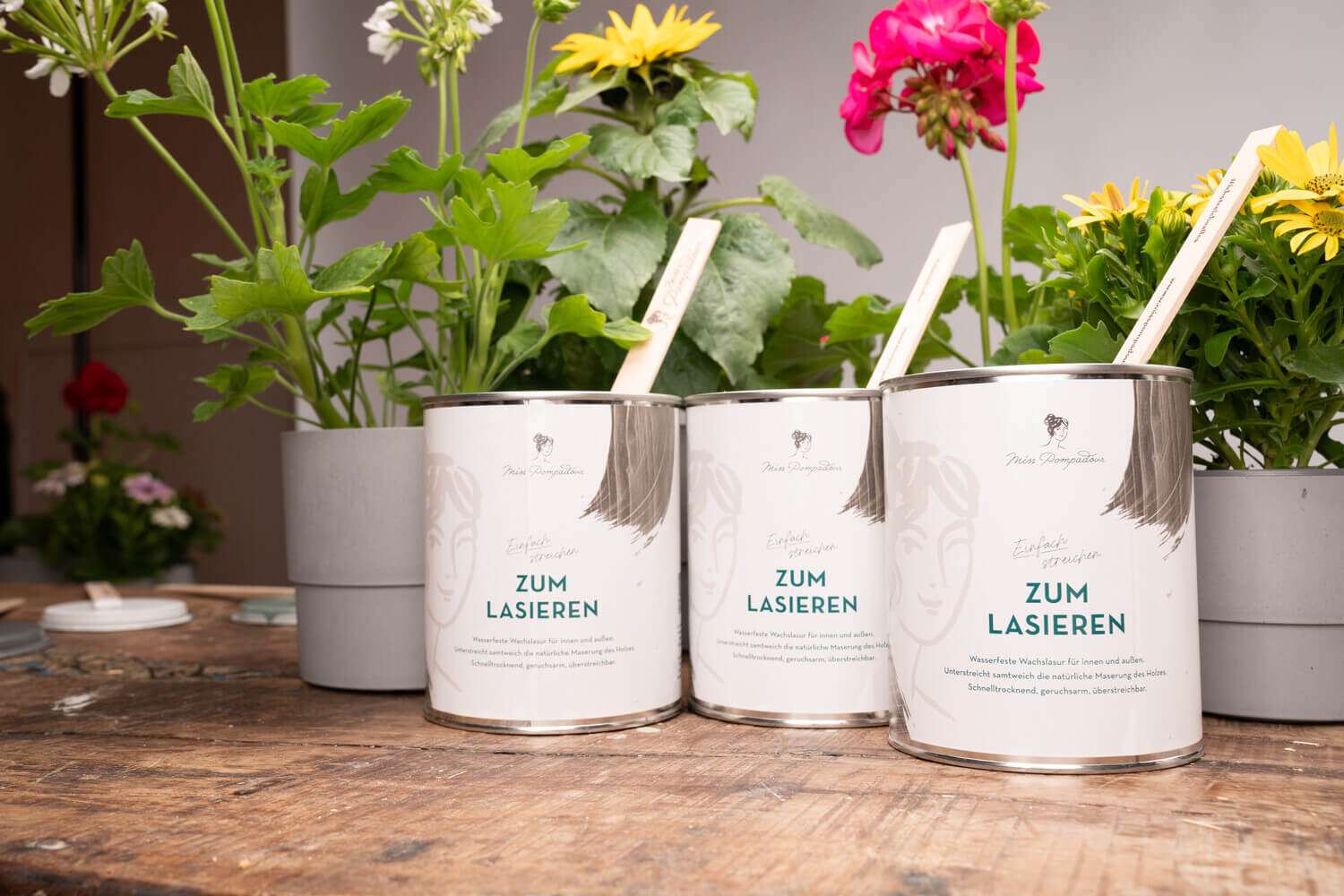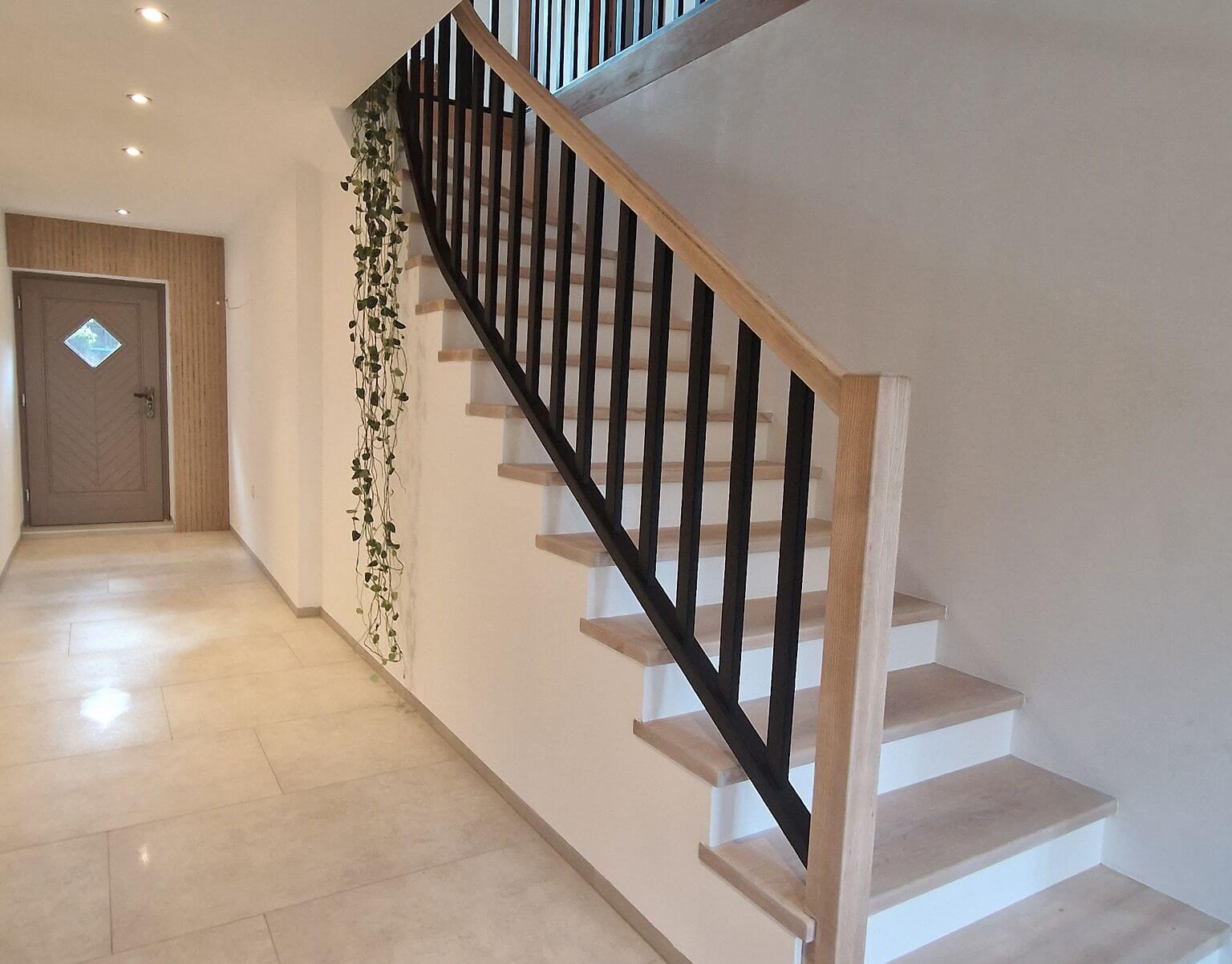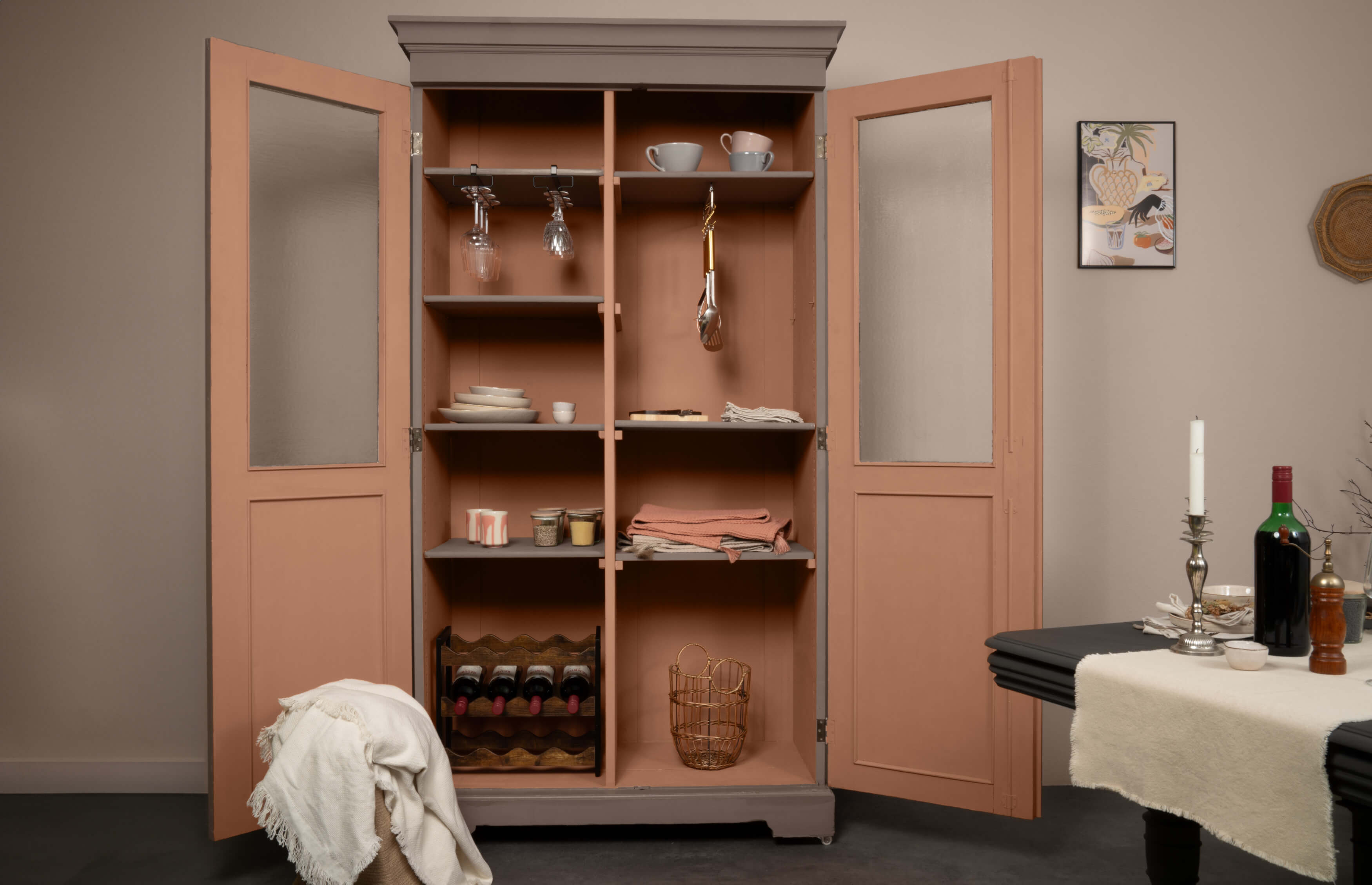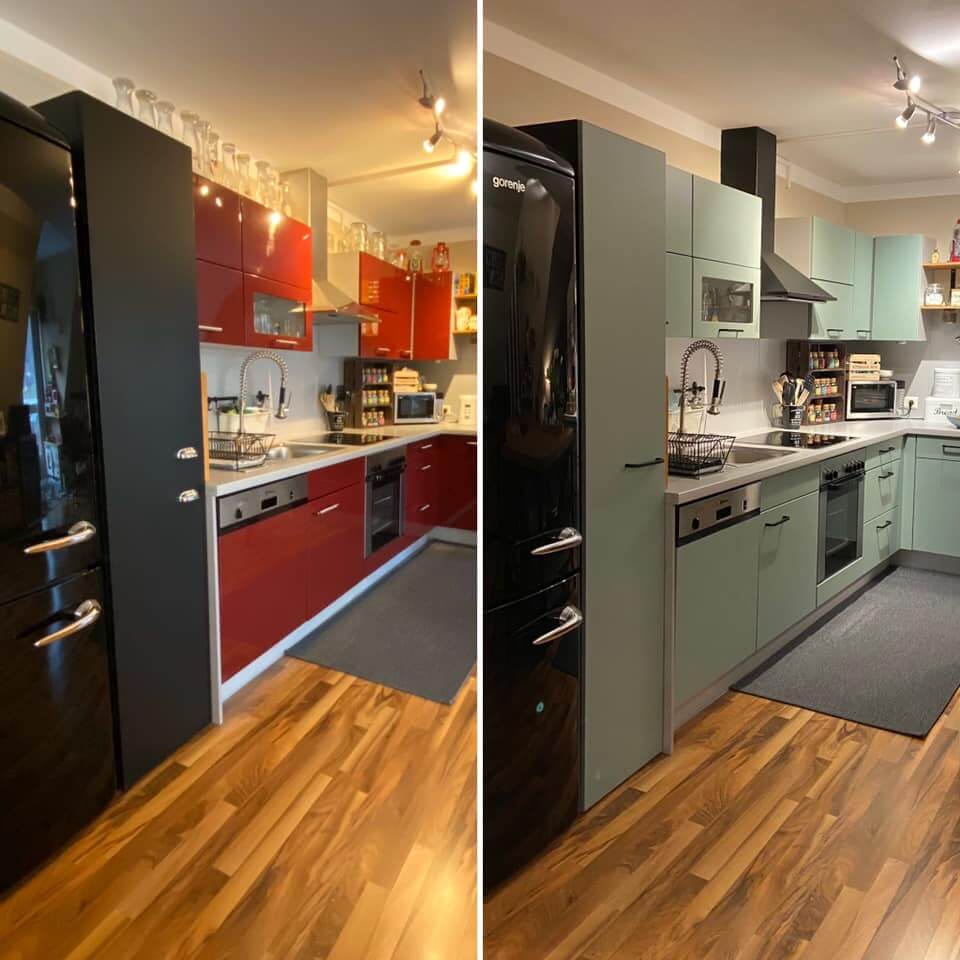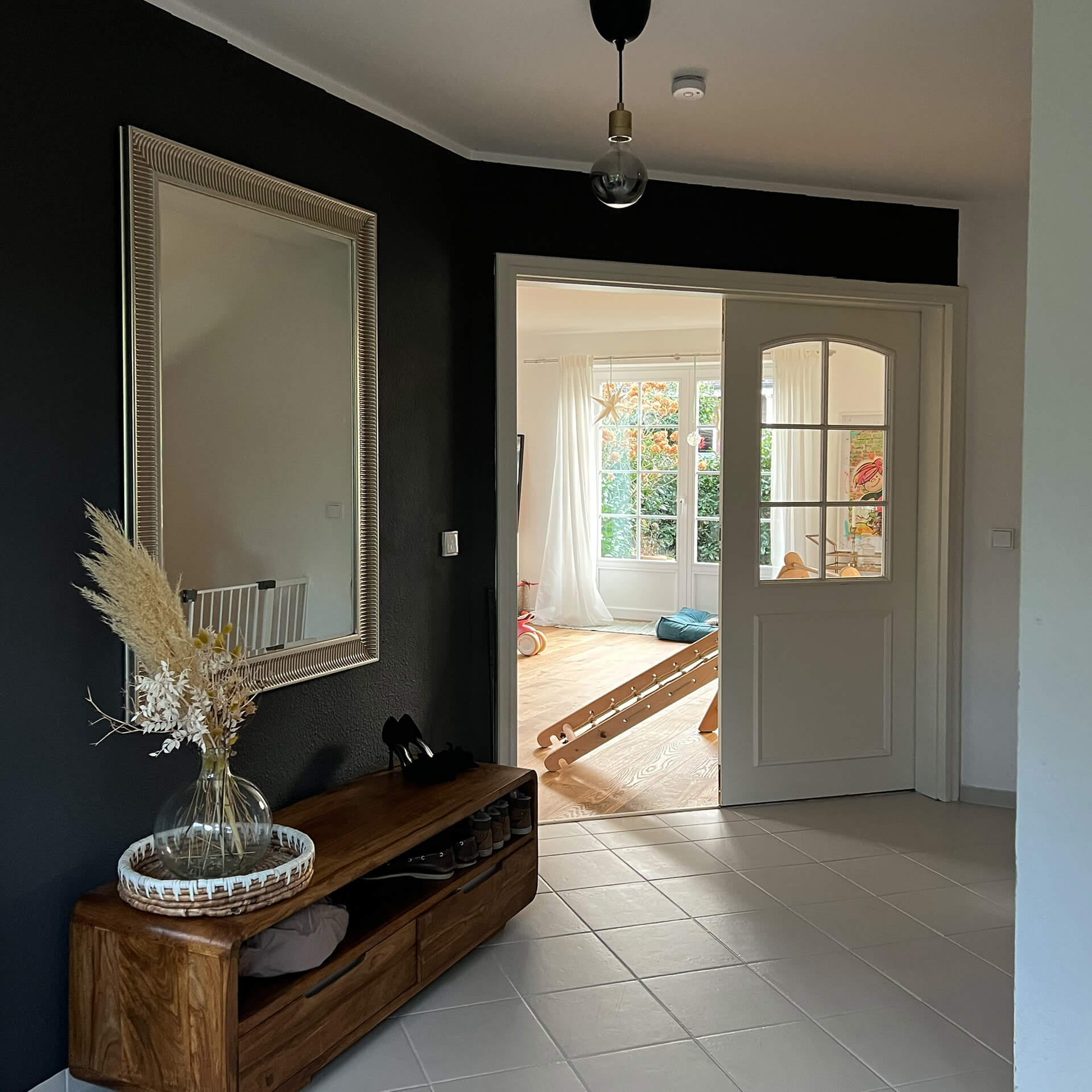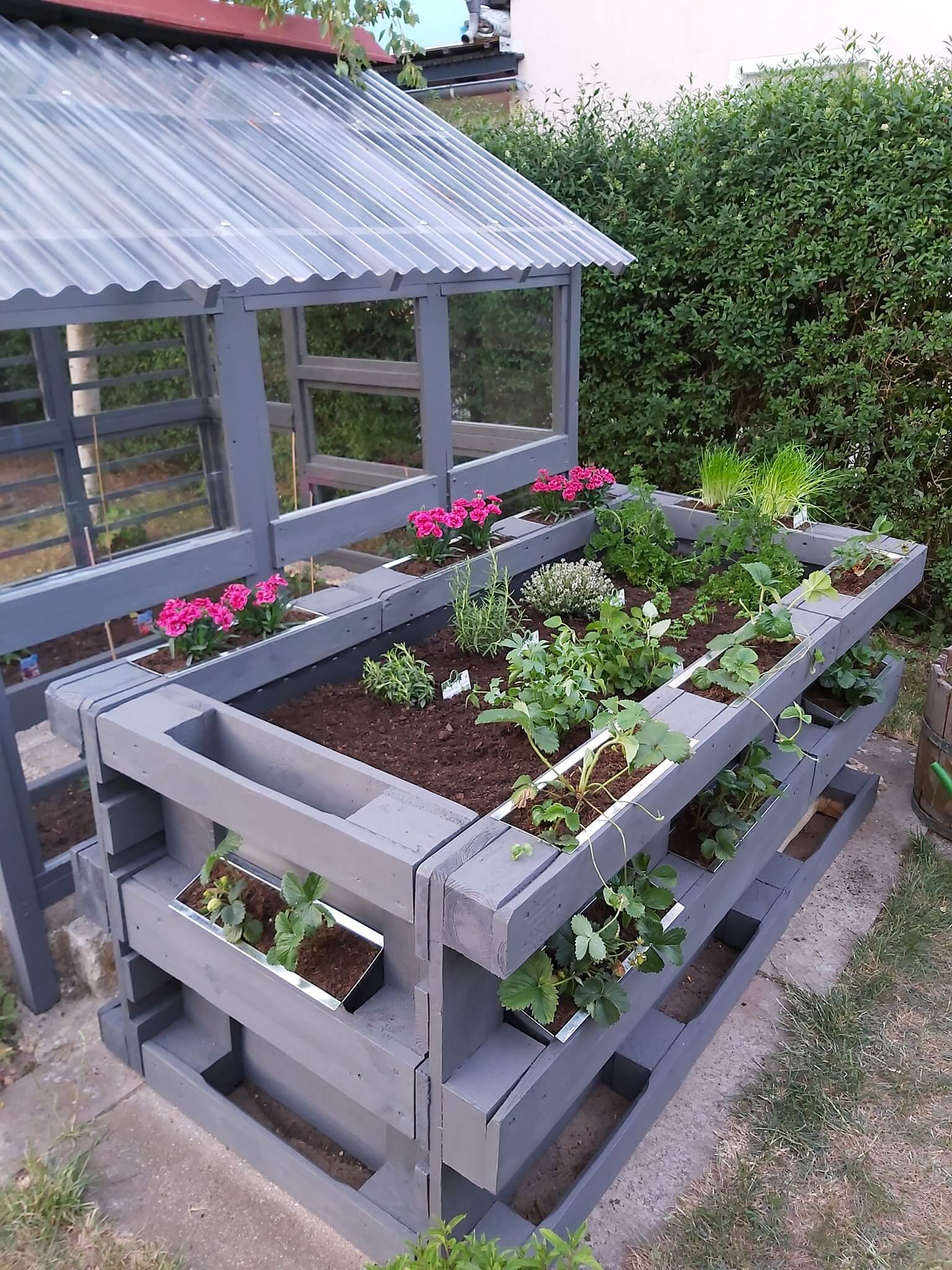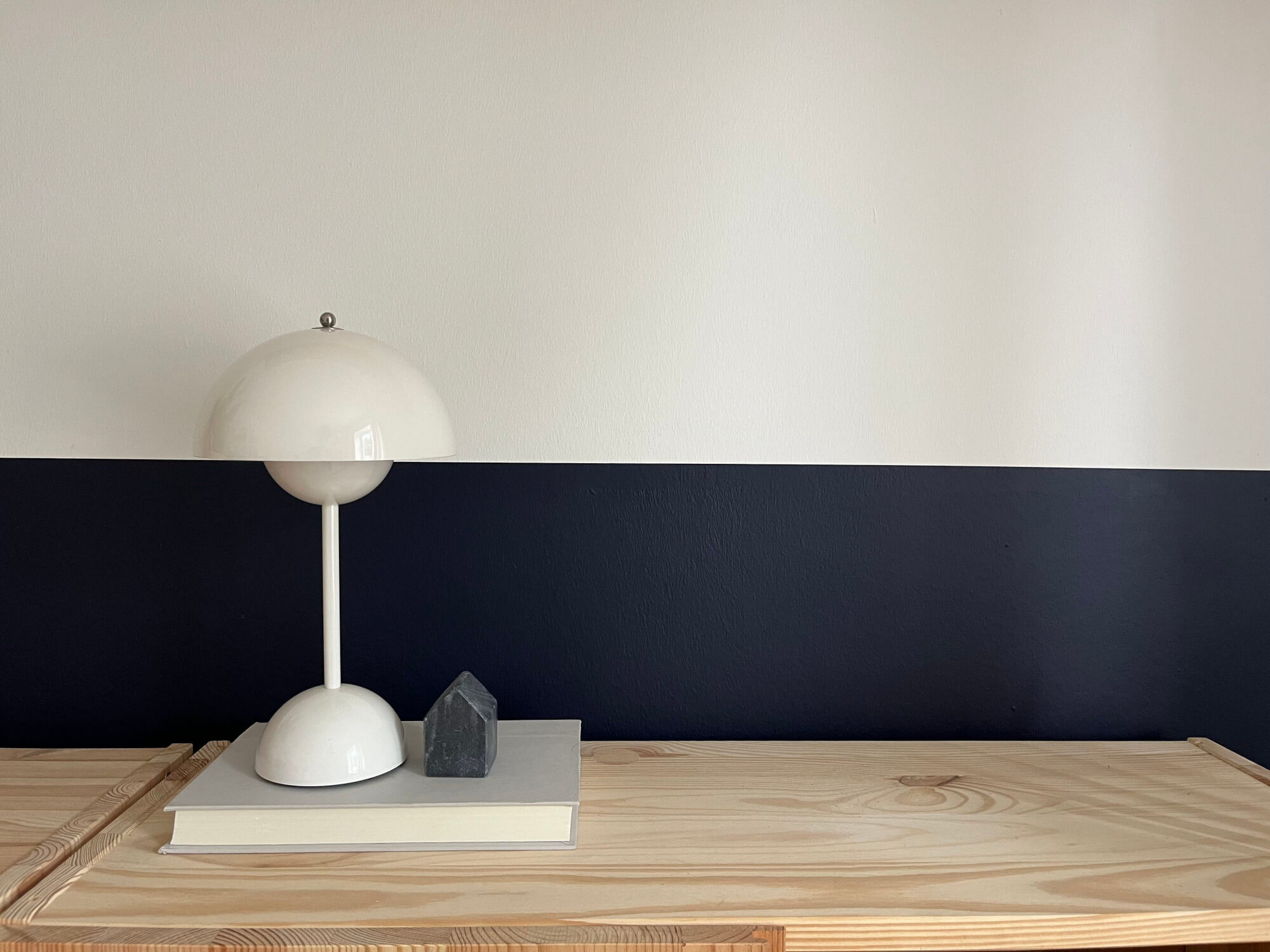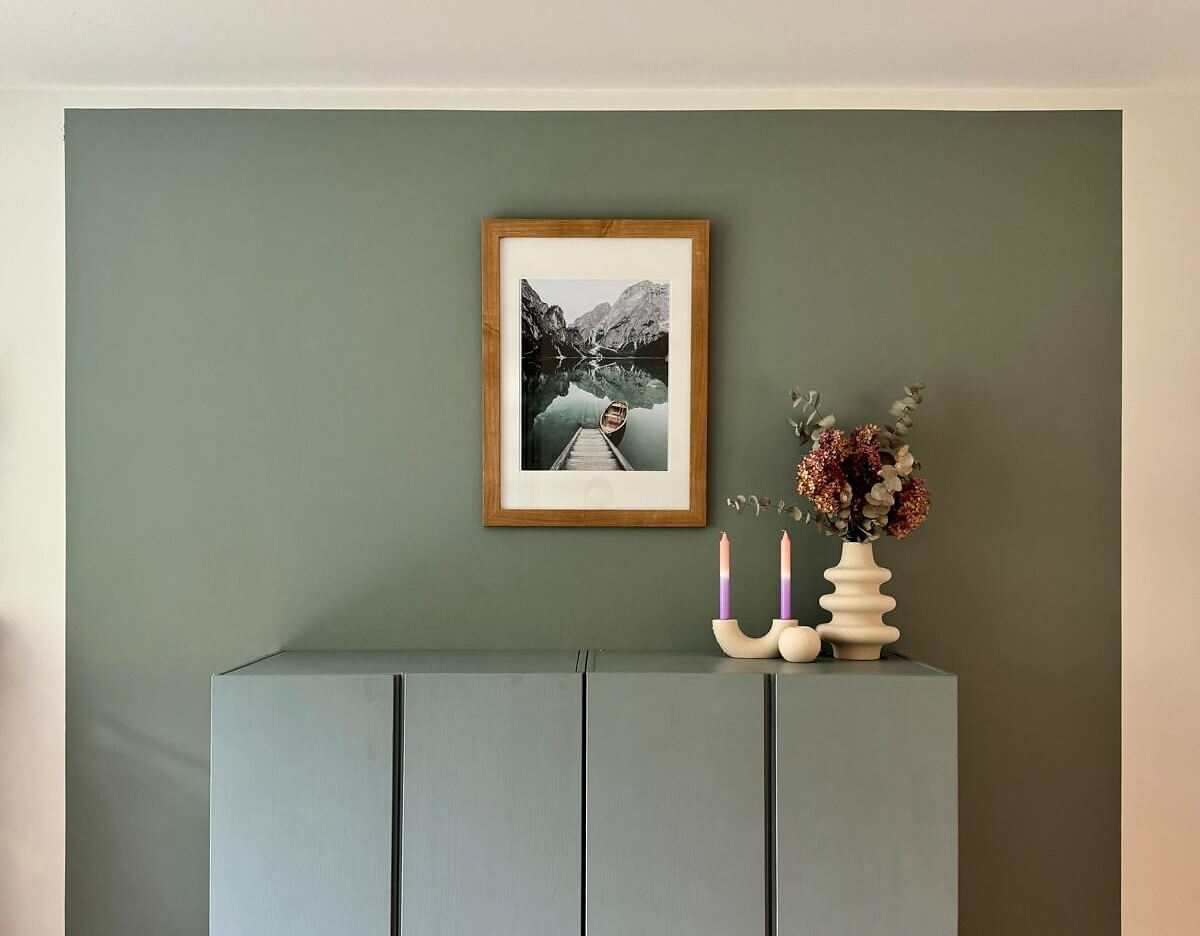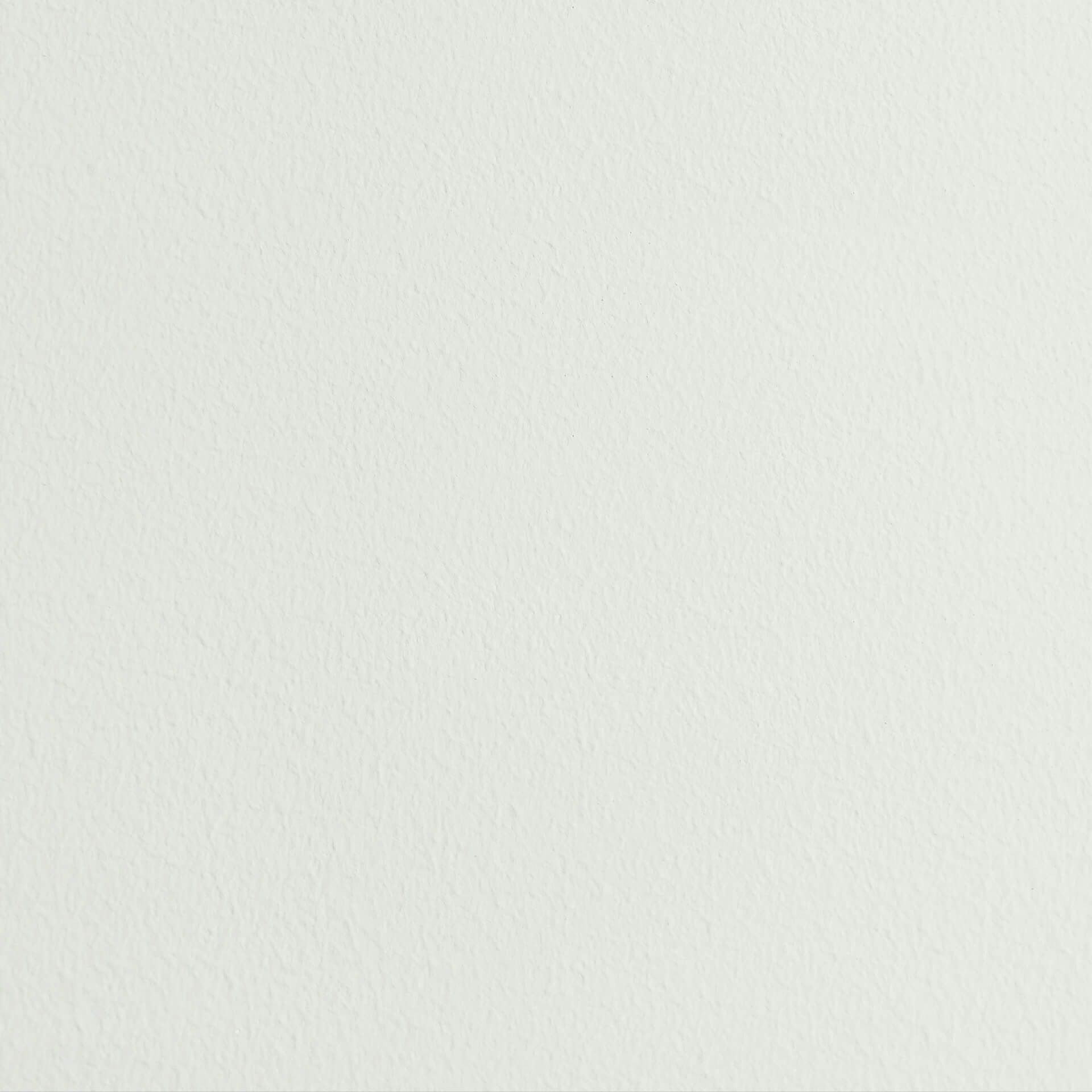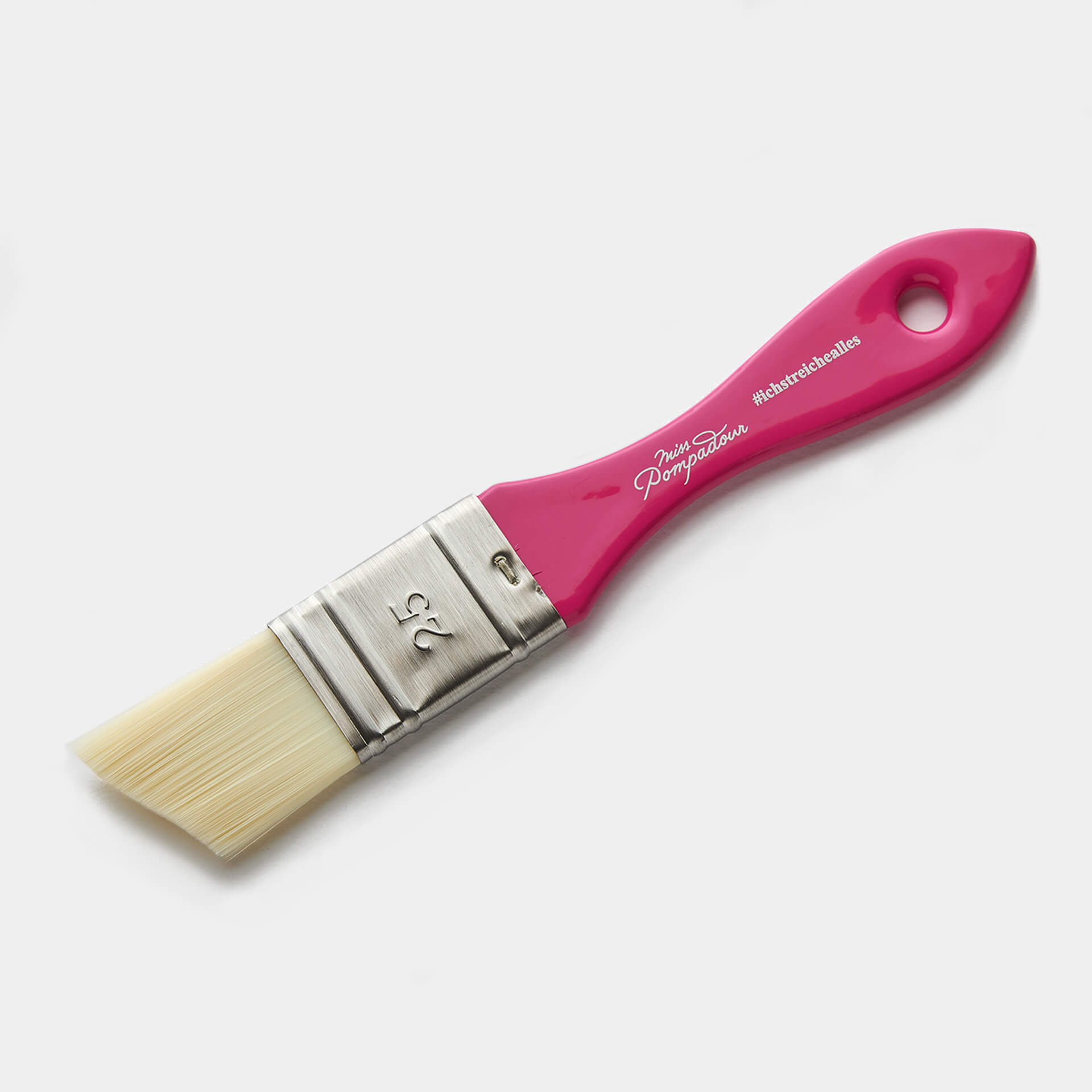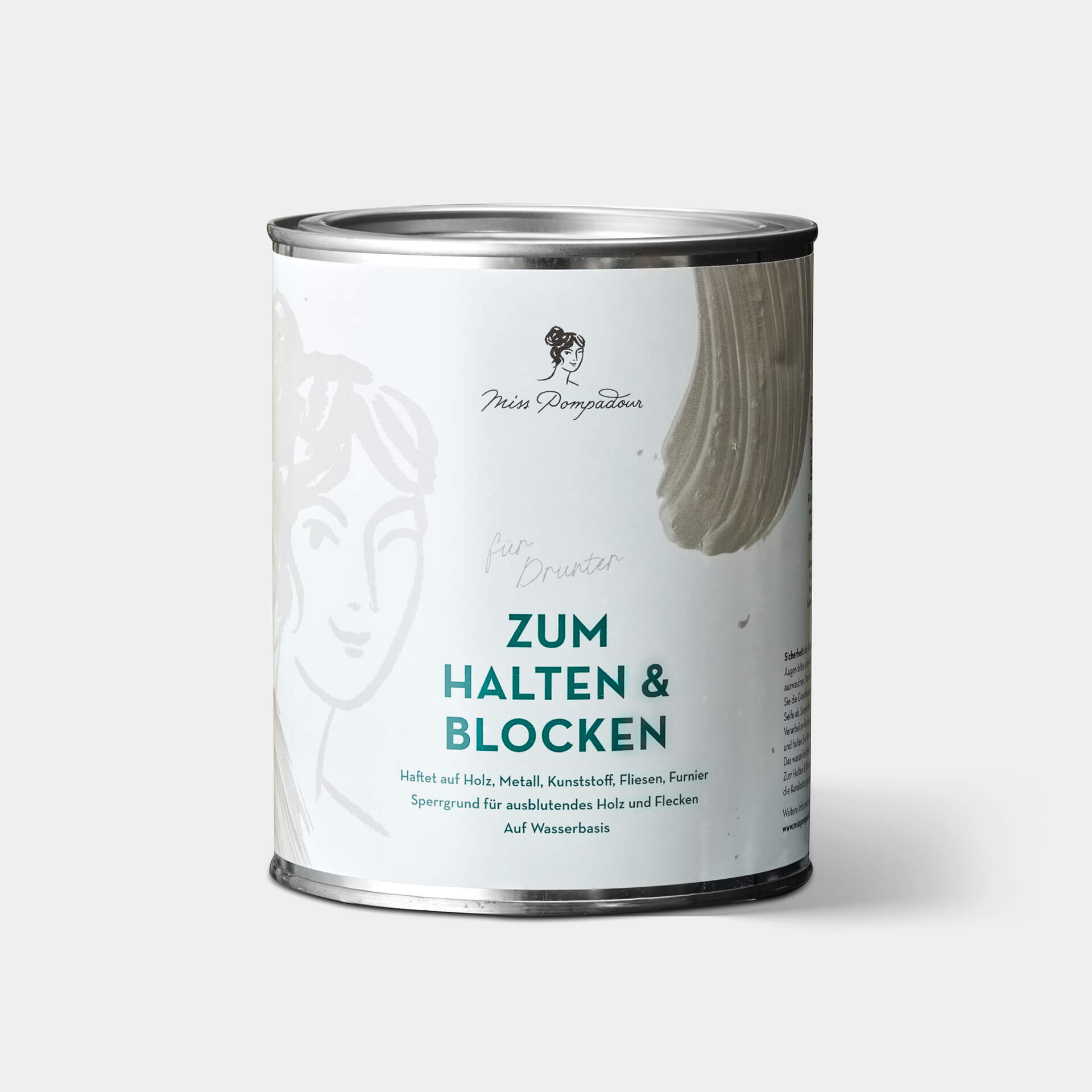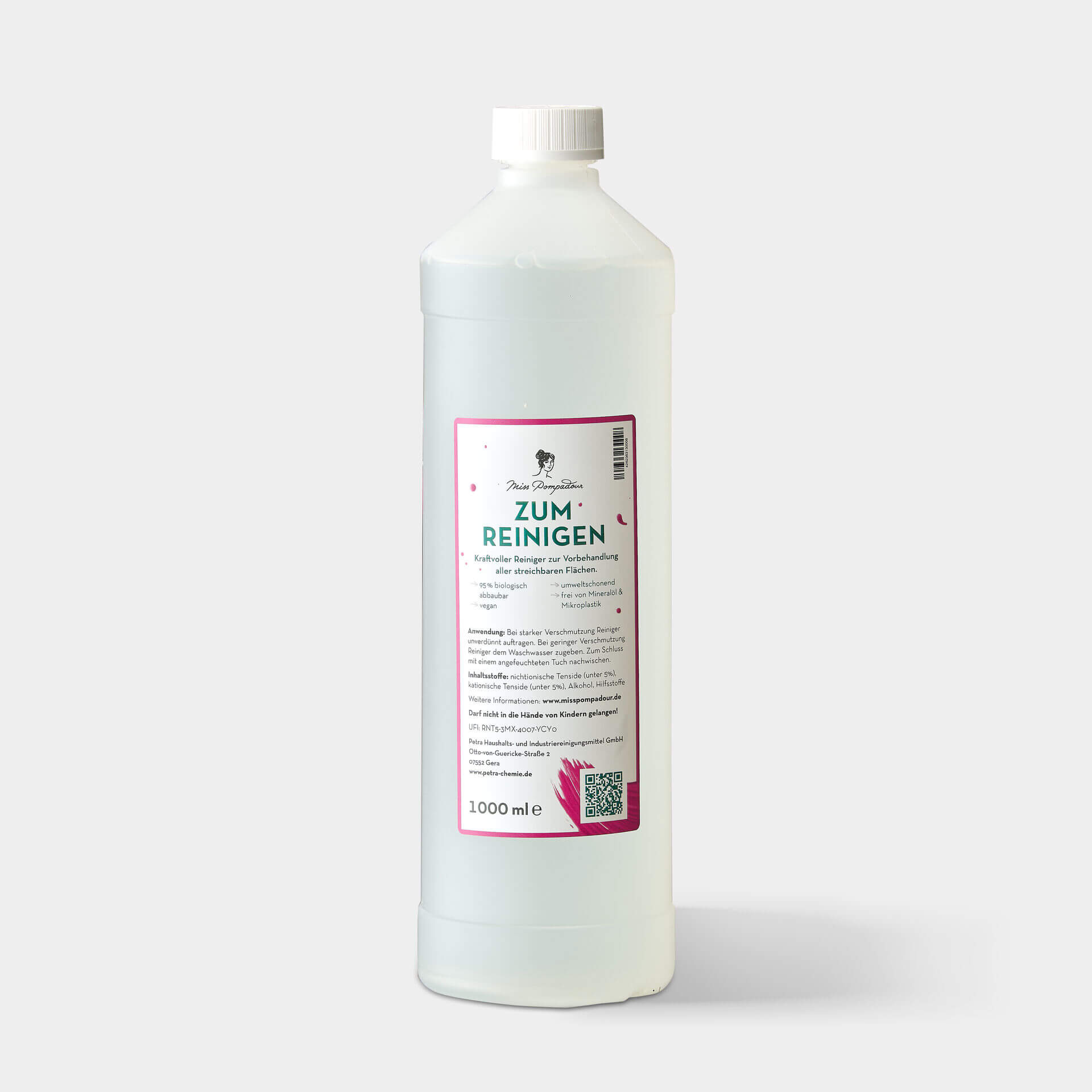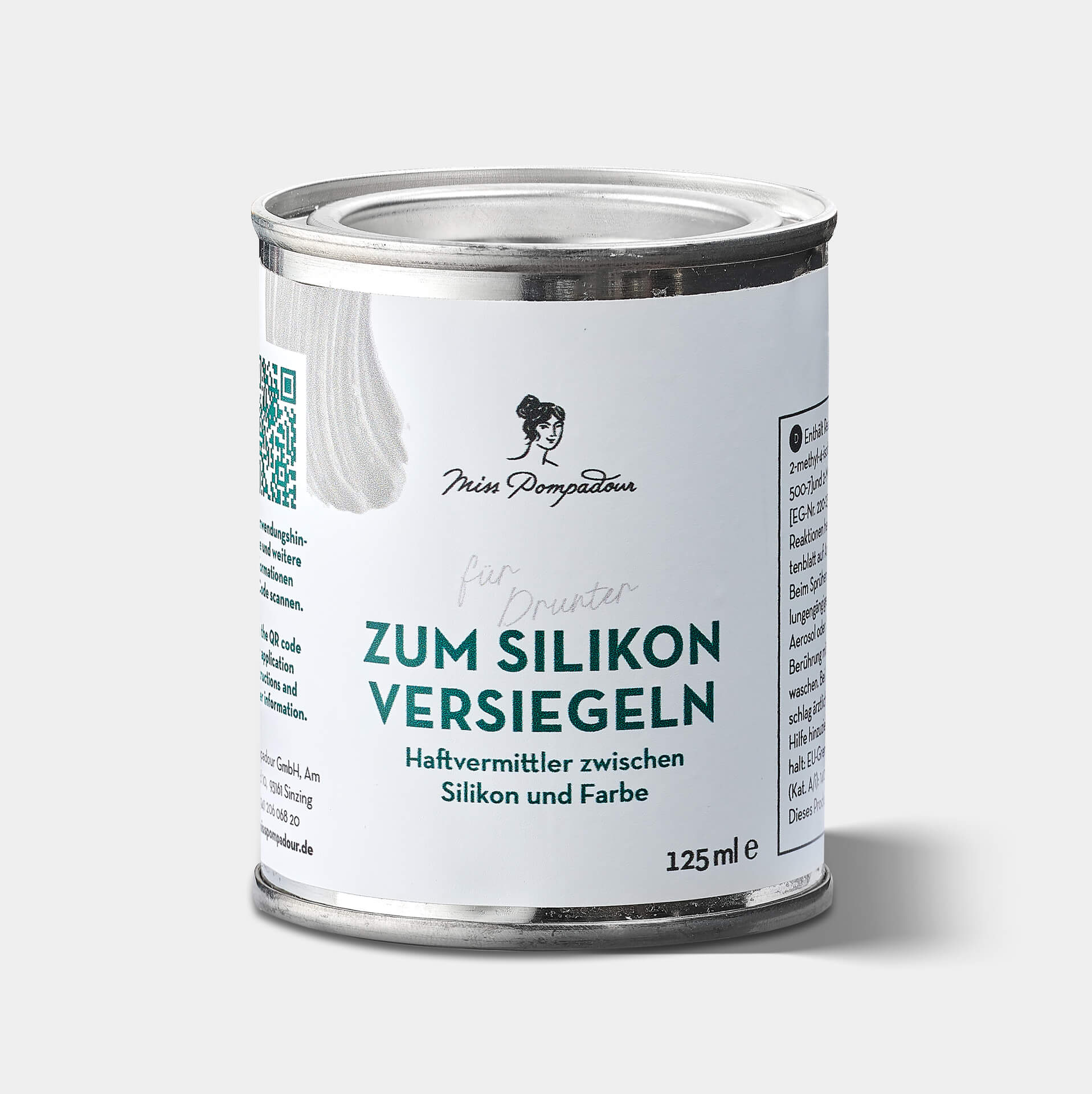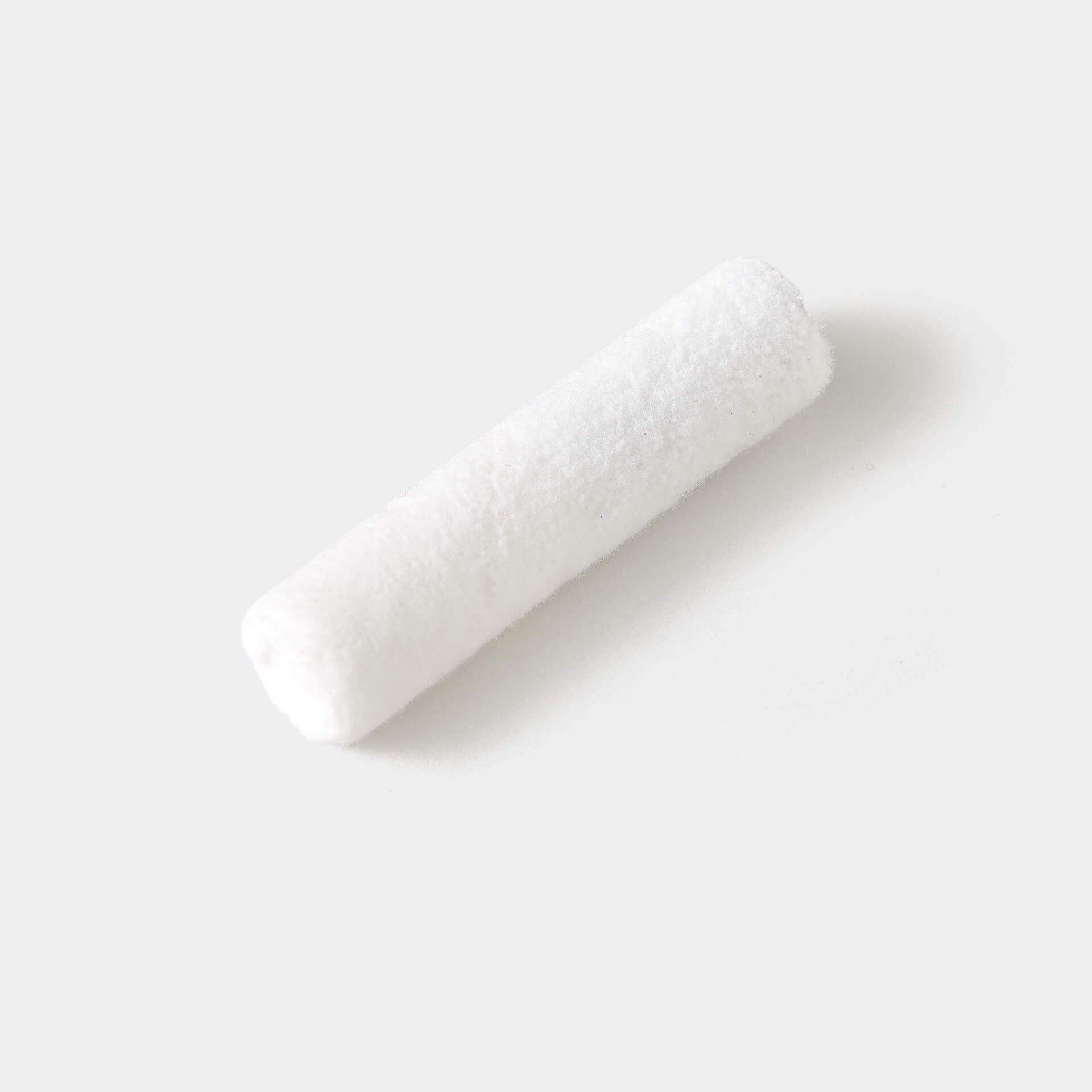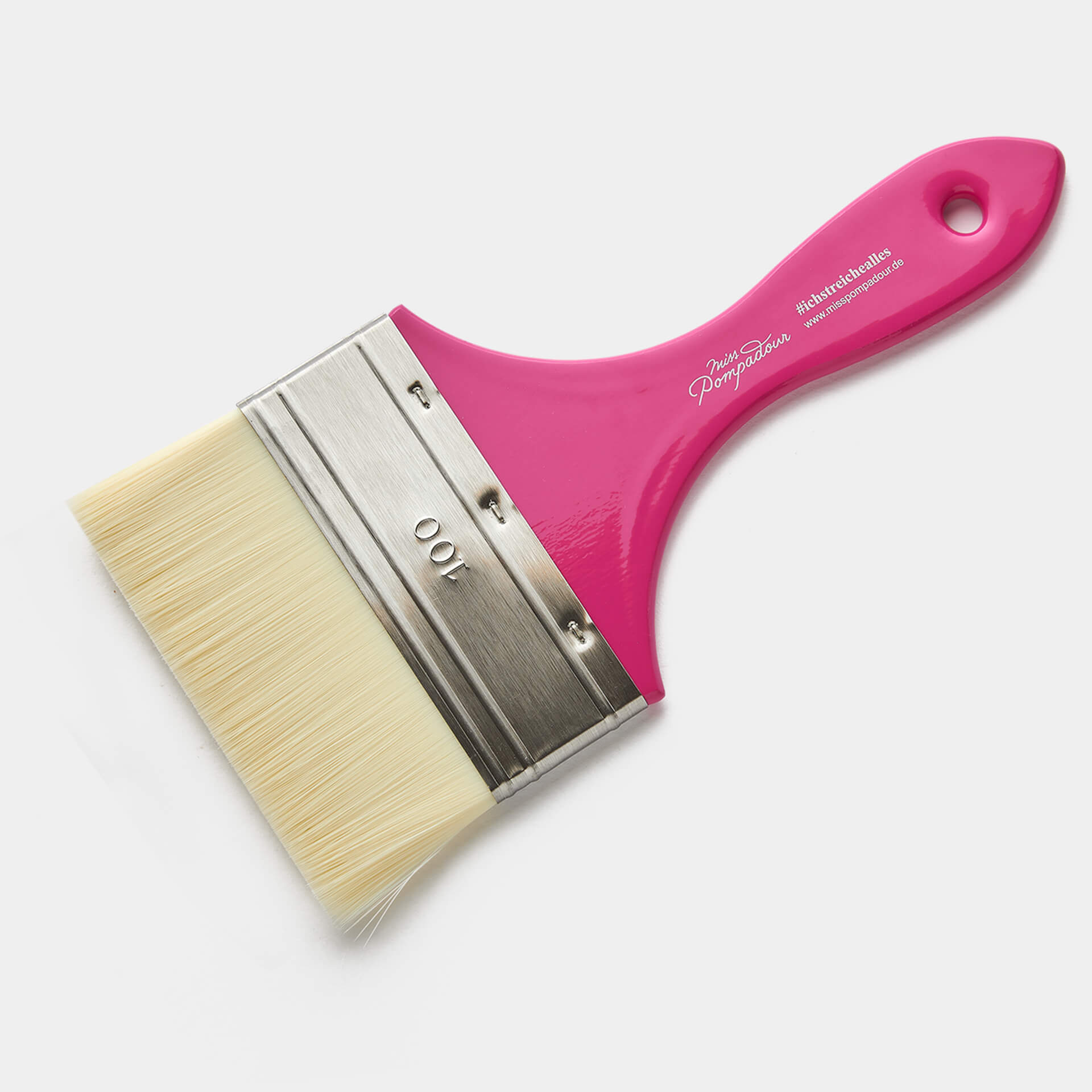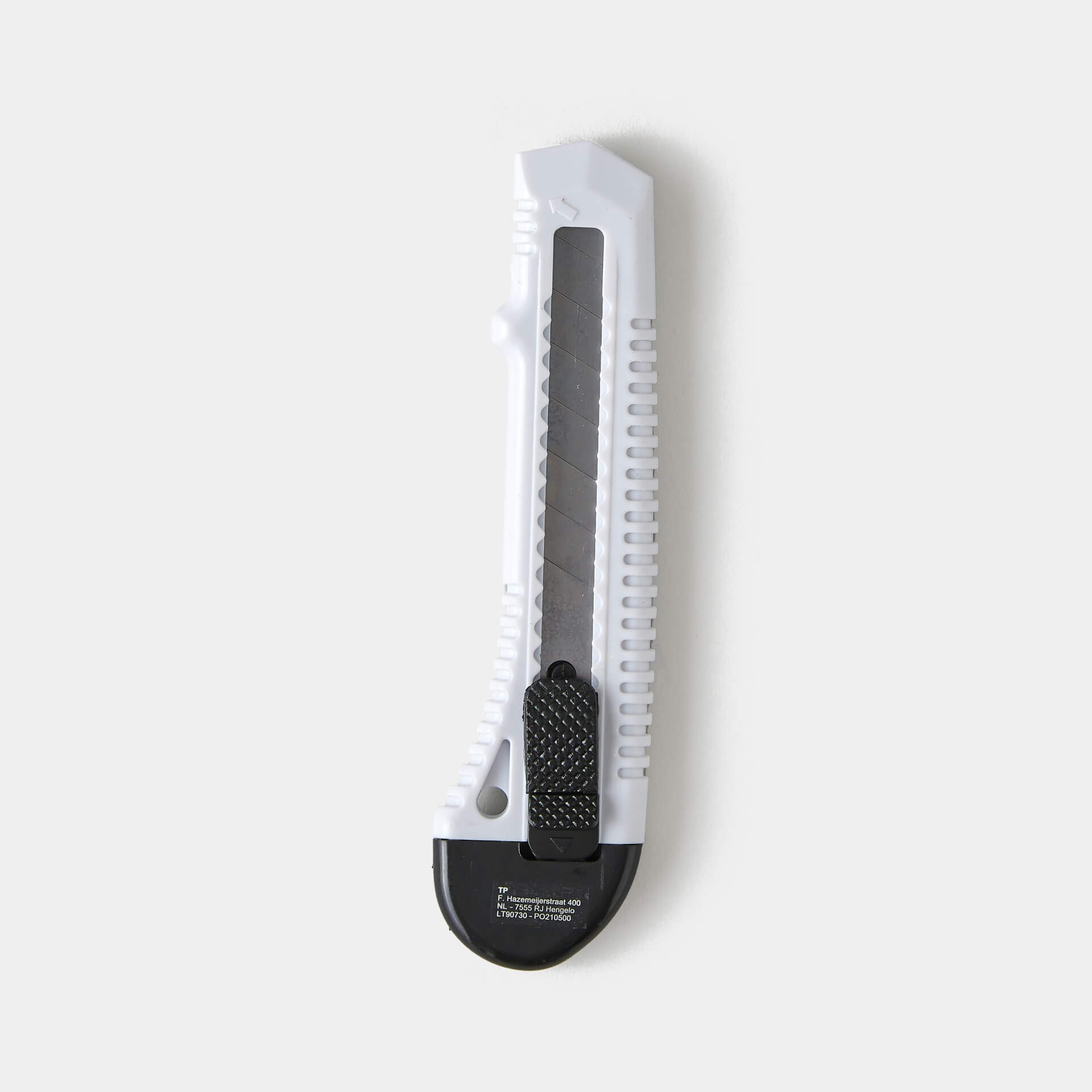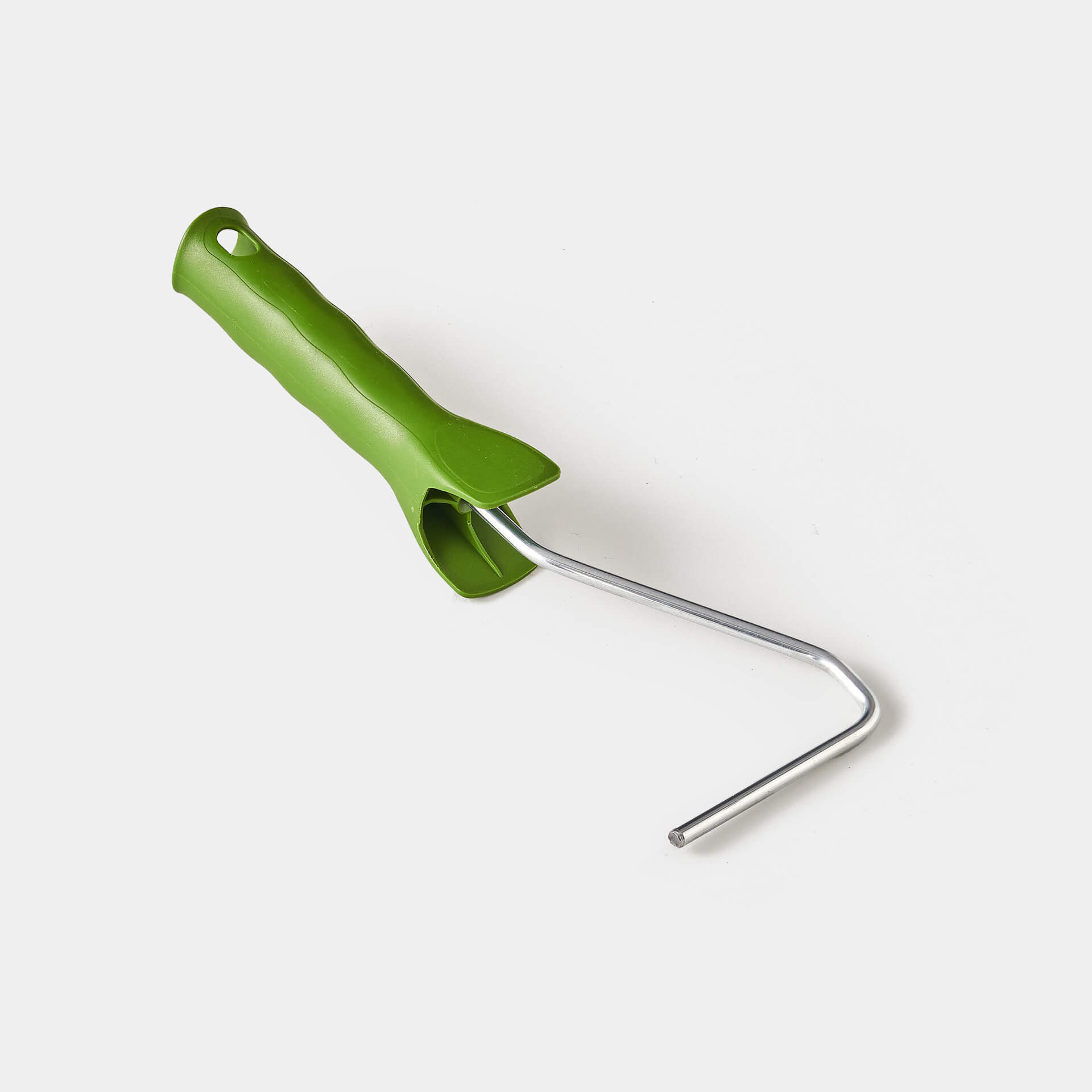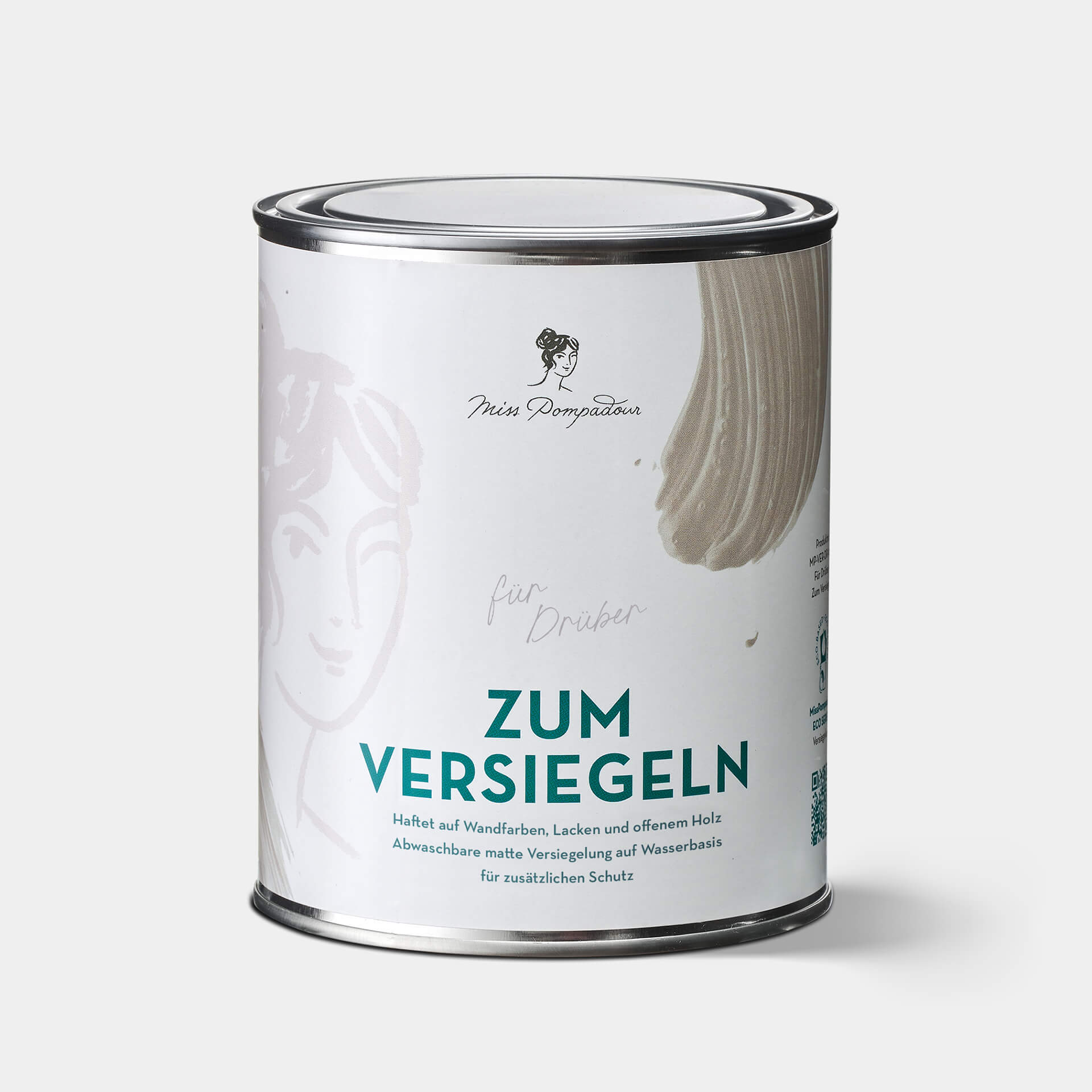Painting Tiles in Kitchen and Bathroom: the MissPompadour DIY-Tutorial
In Painting - How-To · 15 min reading time
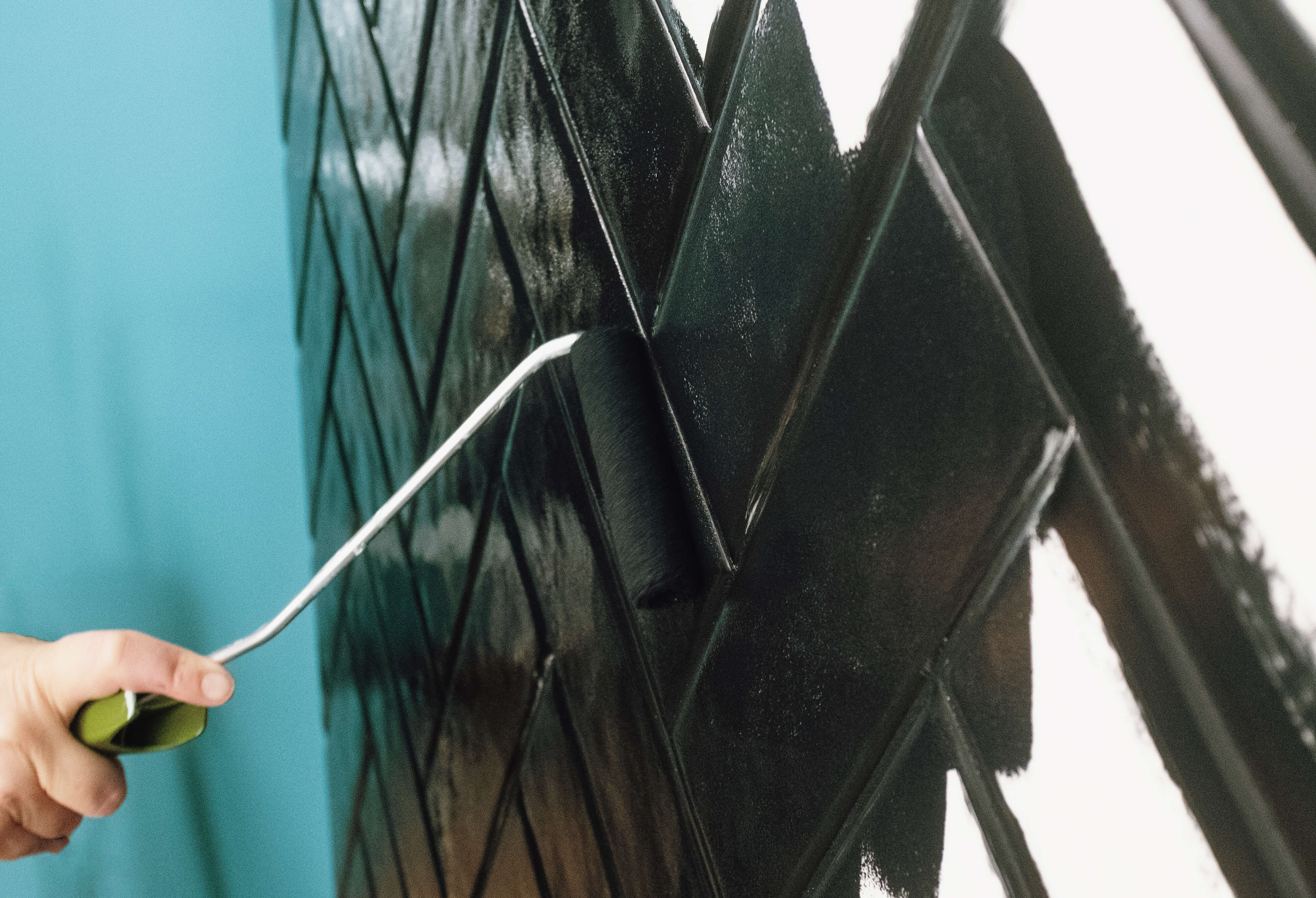
You want to paint your tiles? In our product set you will find everything you need for a perfect result!
Painting Tiles: Before/After pictures from our painting community
Why should you paint your tiles? Because you can! With relatively little effort, you can transform your old, unattractive tiles with a new colour coat. Our customers have already transformed hundreds of bathrooms and kitchens and given some old tiled surfaces a brand-new modern look. Take a look and let yourself be inspired!
Wall tiles in the bathroom
Painting bathroom tiles can take courage. But the result is all the more convincing! Take a look at how our customers have embellished their bathrooms.
Kitchen tiles
Sometimes all it takes is a little fresh paint to change the overall impression and make an old kitchen look modern again.
Floor tiles
From ugly duckling to beautiful swan - that also applies to these floor tiles. See for yourself how much the impression can change with a little colour!
Step-by-step instructions for painting tiles
Step 1: Choose a varnish
You can paint your tiles with chalk paint or our tile varnish. The MissPompadour Eggshell varnishes are particularly suitable. With our large selection of colours, you are guaranteed to find a colour shade that matches your tiles! Our colour cards will also help you with this.
Step 2: Prepare the substrate
You can dismantle anything that is not to be painted beforehand. Drill holes and cracks can be repaired wonderfully with To Fill - MissPompadour Filler. Then simply sand smooth with fine sandpaper.
It is very important for the durability of the colour on the tiles that they do not have a coating. Residues of floor polish and floor wax must be thoroughly removed with special cleaners before painting.
Please note that even our varnishes have limitations. Areas where water remains cannot be painted ! This includes, for example, the floor in the shower or horizontal shelves in the shower.
Step 3: Clean the tiles
To ensure that the surface is completely free of dust and grease, you can use To Clean - MissPompadour Cleaner. To remove particularly stubborn stains such as limescale, you can also use a bathroom cleaner. Please refrain from cleaning grout with chlorine or mould stop. These can build up, leaving deposits in the grout which may lead to adhesion problems. Once cleaned, rinse off all surfaces thoroughly with clean water and allow to completely dry.
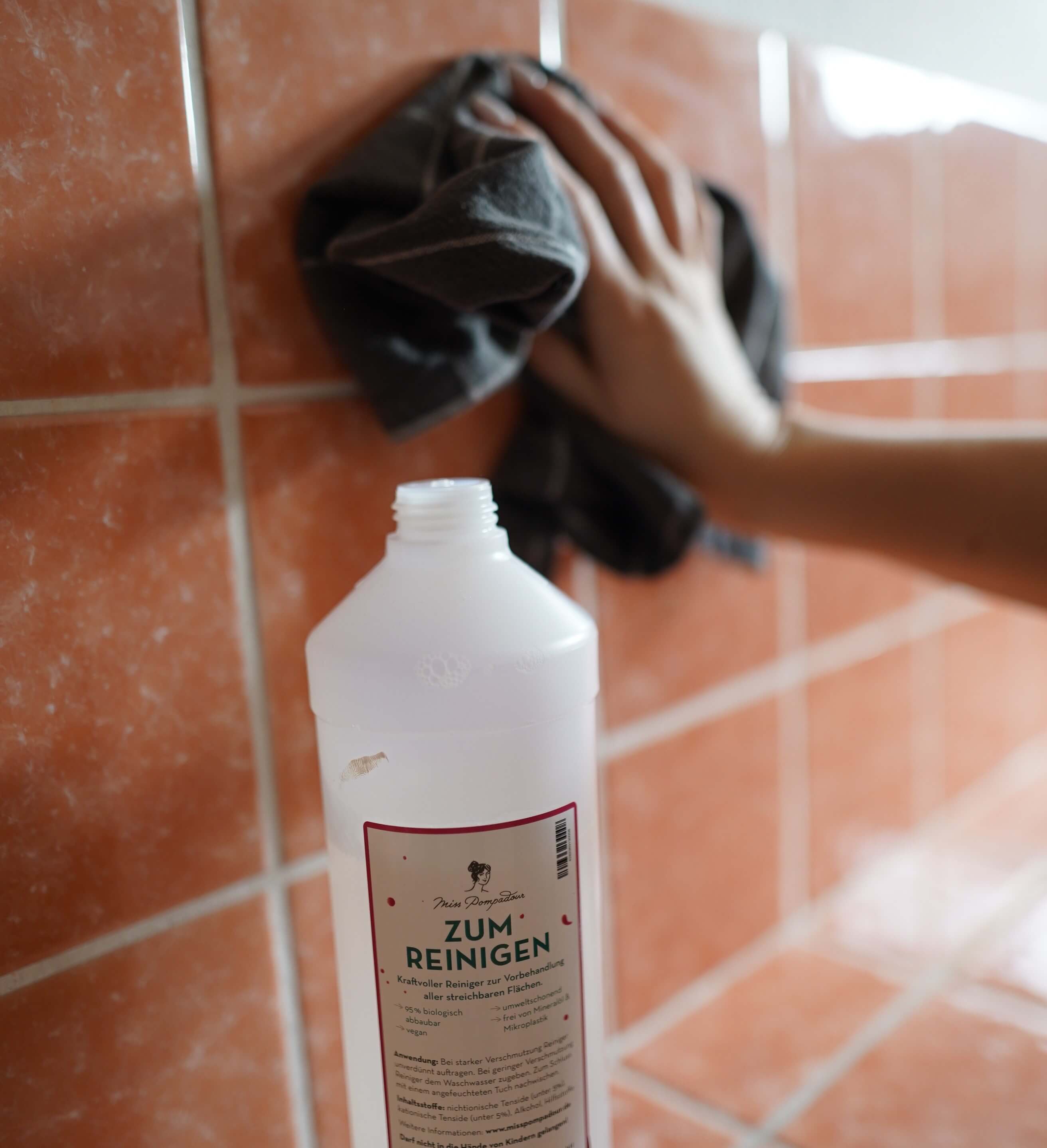
Step 4: Prime surfaces
When painting floor tiles and wall tiles, apply a coat of MissPompadour To Bond & Block to to allow for optimal adhesion. Cold exterior walls, small spaces and high humidity sometimes slow down the drying time. In such cases, simply take longer breaks and apply the first coat of paint after ca. 6 - 8 hours or leave the primer coat to dry overnight. Be sure to use clean tools when painting the primer.
If you have silicone joints that you want to paint over, prime them first with our To Seal Silicone, since water-based paints will not adhere to silicone. Primed, it is no longer a problem.
Step 5: Paint the tiles
Now you can apply the varnish. Apply as many coats as you like until you are happy with the result. Two coats are usually enough for full coverage and an even finish, but sometimes an extra coat or two is required, depending on colour and application. Let each coat dry thoroughly. Usually 4 - 6 hours is sufficient, but depending on environmental conditions, drying may take longer. The surface will become more stable with each day and will have reached a very good level of stability after 10 - 14 days. Deeper joints are best pre-painted with To Paint - Fine MissPompadour Brush in 25mm. Then paint the tiles with the varnish roller for water-based varnishes. Make sure you apply the paint wet in wet . To do this, first paint a few joints and then roll the corresponding tiles, then continue with the next section.
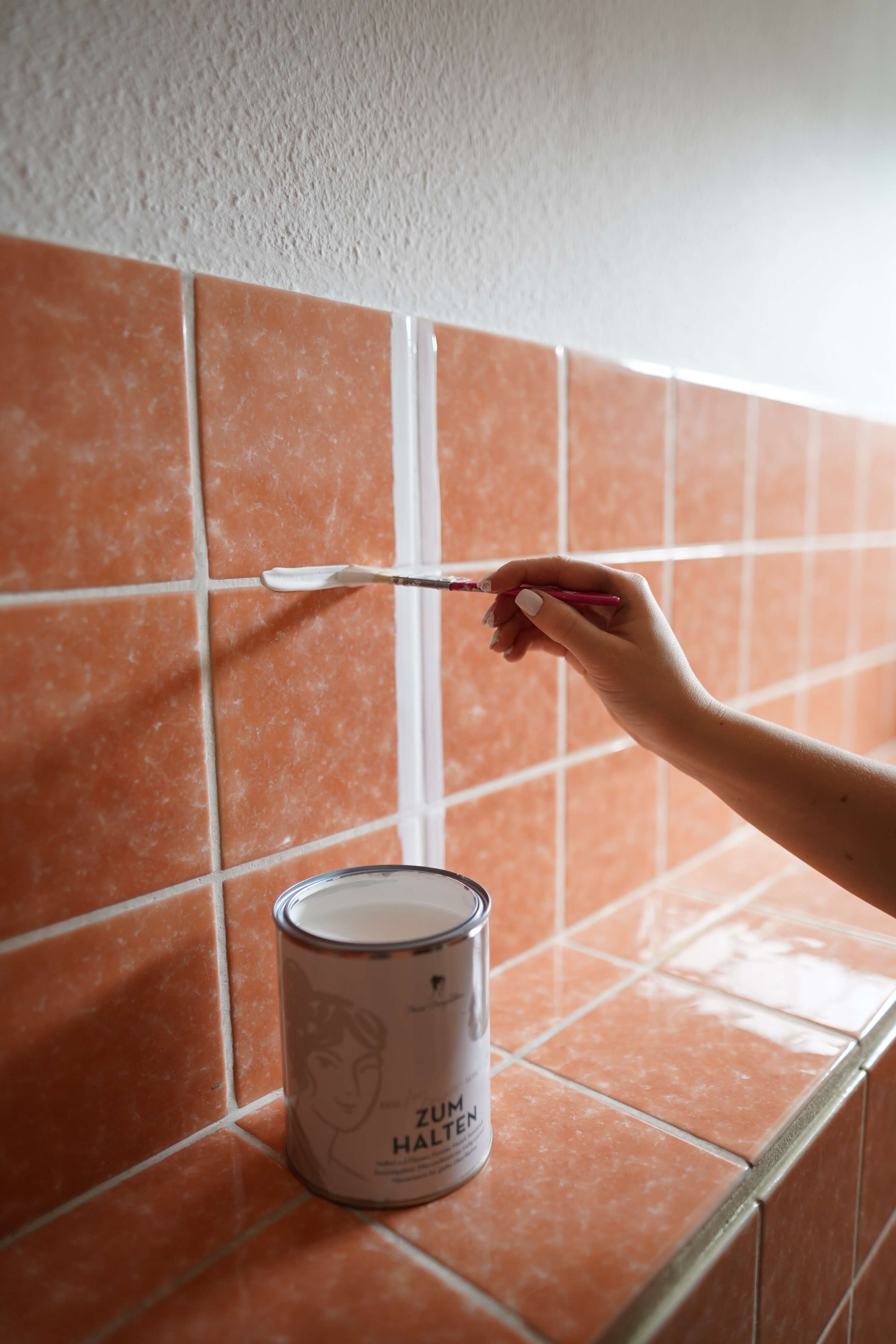
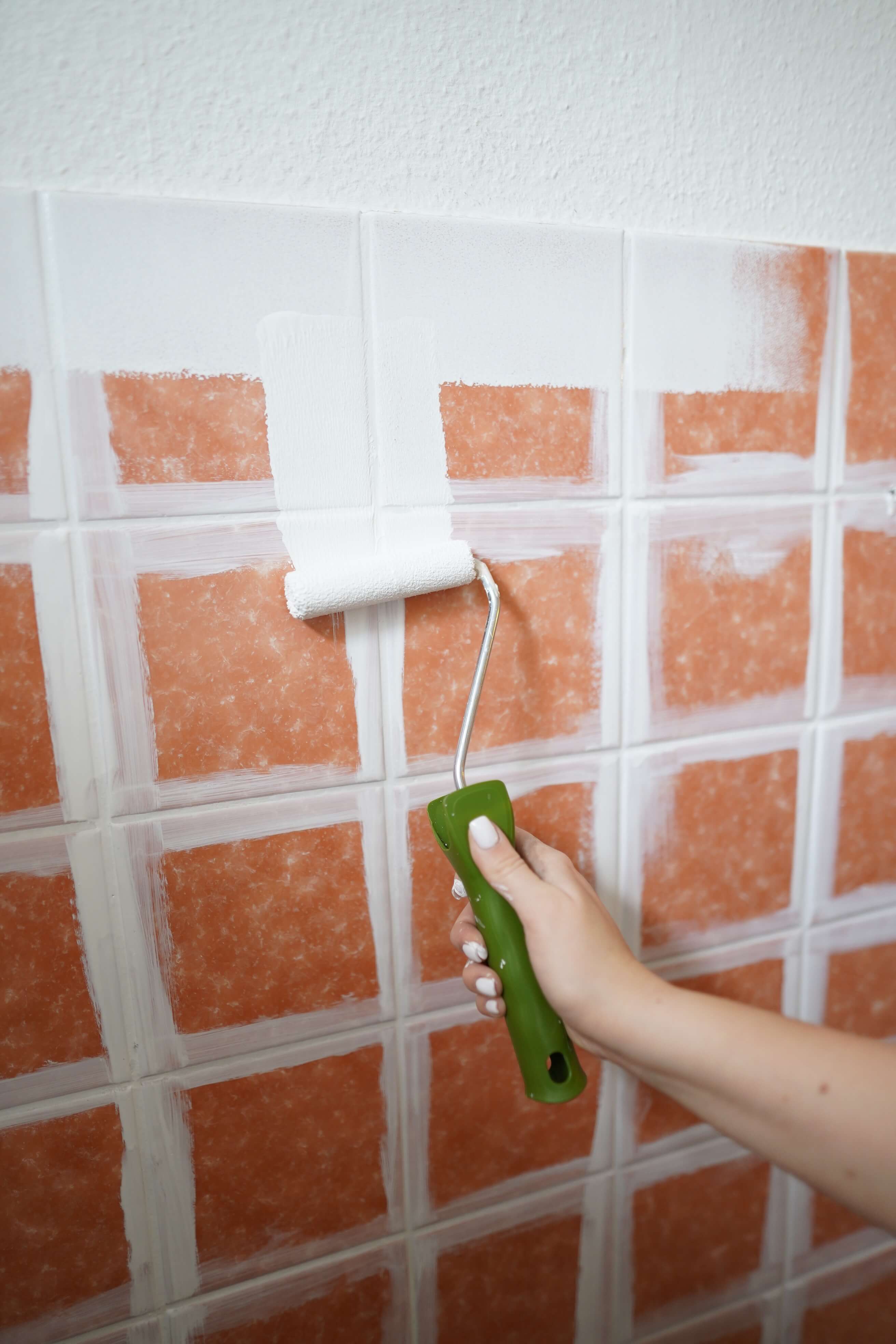
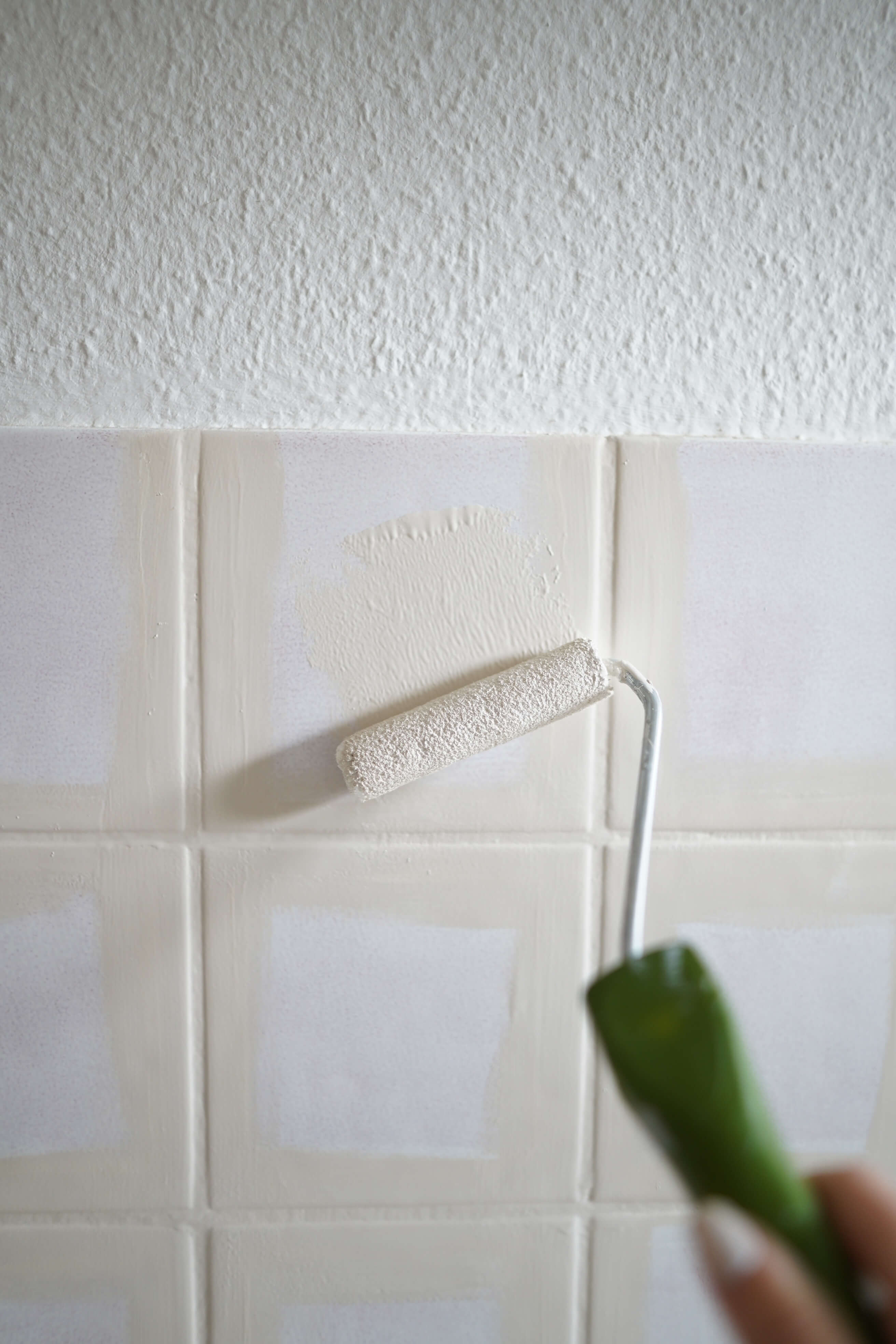
Step 6: Seal the result
If you are painting floor tiles or other heavily used tiles, To Seal - MissPompadour Topcoat will ensure that your coating lasts as long as possible. Wall tiles that are often exposed to moisture, such as in the shower or behind the cooker, can also be protected with To Seal. Floor tiles in the shower or other areas where standing water collects cannot be painted. Wait 24 hours after the last coat of paint before applying the topcoat.
Pro tip #1: If you need to paint over silicone joints, you can prime them with MissPompadour To Seal Silicone beforehand and then simply paint them as well.
Pro tip #2: Always remove tape when the paint coat is still wet. This prevents the paint from lifting when removing the tape. Then tape off again for the next coat.
Pro tip #3: If you want to reapply tape to your painted tiles, the varnish coat should be completely cured. In this case, give the paint ca. 14 days. Depending on humidity and temperature, drying times may vary. Simply test the varnish on an inconspicuous spot.
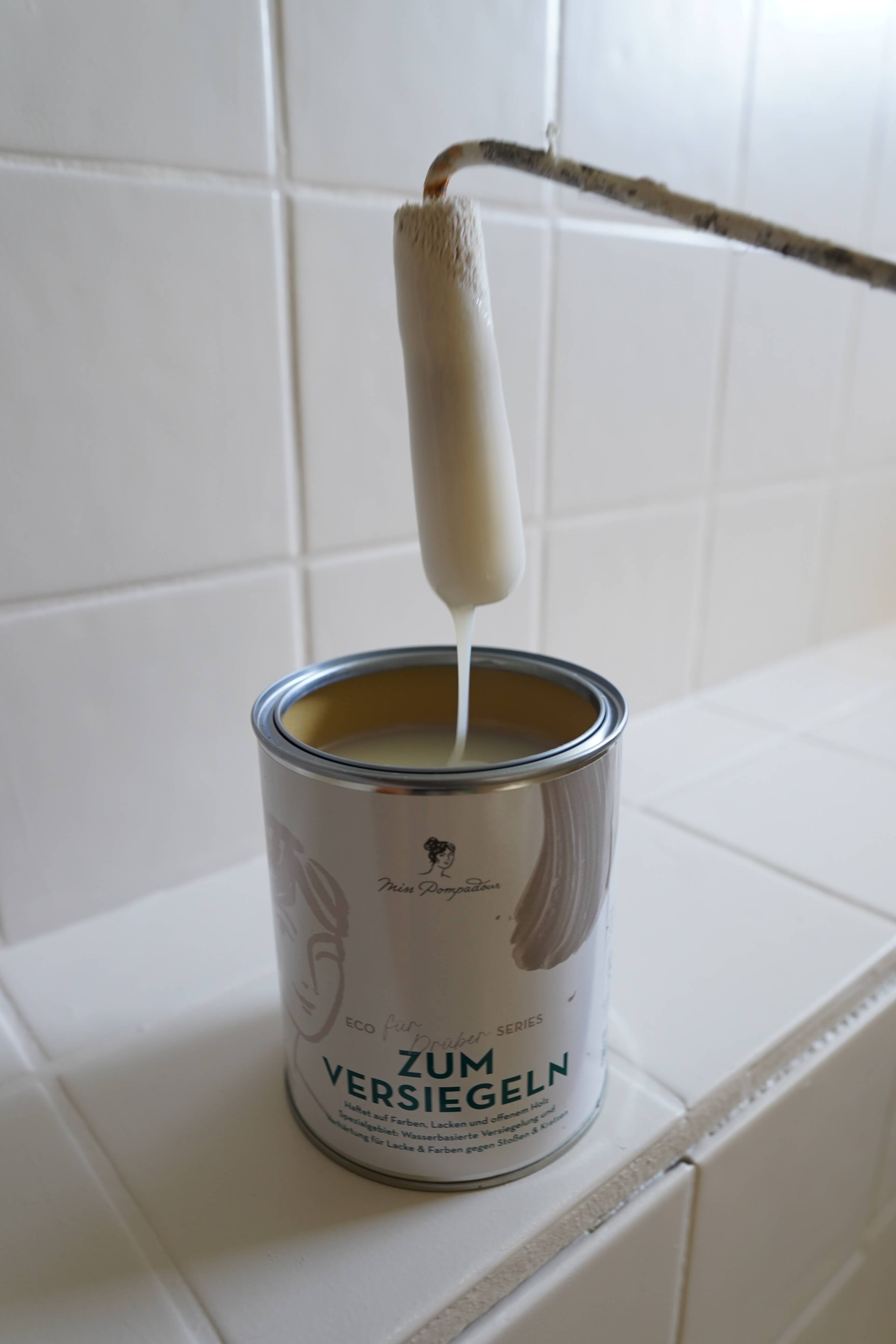
Note: Please keep in mind that horizontal surfaces are particularly vulnerable. Whether as a storage shelf or floor, they are exposed to higher loads or even standing liquids and heavy moisture, which must be taken into consideration. We can therefore not guarantee durability.
Which colour is suitable?
Which paint is suitable for painting my old tiles?
What distinguishes tile paint at MissPompadour?
Painting tiles with chalk paint
Video tutorial: Painting instead of re-tiling
You still need these accessories for your tiles
- Cleaning bucket, sponge and cloth: The surfaces to be painted should be free of dust and grease. Lime deposits should be removed as best as possible.
- Screwdriver for dismantling: It is best to remove all towel rails, hooks and furniture. This is the cleanest way to work and saves you a lot of tedious masking.
- Masking tape for masking: It is best to always remove the masking tape when the paint is not yet dry, so you get a clean edge. Please also read the instructions in the FAQs.
- plastic drop cloth or newspaper: This protects the areas that should not get any paint.
- Brush, varnish roller and paint tray: It is best to pour the varnish into the paint tray. Paint corners and edges as well as all joints with the brush, the surfaces with the varnish roller.
- Sandpaper or sanding pad: To be on the safe side, it's a good idea to have something to sand with. This way you can easily touch up small blemishes such as noses on the joints and continue working.
Frequently asked questions about painting tiles
1. General questions about painting tiles
Can you simply paint over tiles?
Yes, you can! Basically, you can paint almost all tiles, but it's especially easy an eggshell varnish.
Which tiles can I paint?
Almost all tiled surfaces can be painted. There are, however, a few exceptions: Tiles coated with wax or treated with an impregnating agent are difficult to paint over/b>. Terracotta tiles, for example, are often sealed with a wax coat to make them easier to clean. Modern surfaces with a lotus effect coating cannot be painted either. Even some floor care products that have an impregnating effect. Outdoor tiles that are exposed to rain are also not a suitable surface for painting. Of course, every surface is different and reacts differently to a coat of paint, therefore, we cannot guarantee proper adhesion and durability.
Which paint roller and brush do I need to paint tiles?
It is best to work with a combination of our fine MissPompadour brush and the varnish roller for water-based varnishes. Pre-paint the grout lines with the brush held lengthwise and then the tiles with the roller. Always try to work wet in wet. So first paint a few joints and then roll the corresponding tiles. Then paint the next joints and tiles. You'll soon get the hang of it.
How long does the colour last?
We cannot guarantee the durability of tile painting. In fact, how long a coat of paint lasts on tiles depends very much on how it is used. Every painted surface is subject to a certain amount of wear and tear, and this wear and tear depends on the amount of use. For example, a tiled floor in a single household without pets, where shoes are consistently taken off at the front door, is naturally subject to different wear and tear than in a family of 5 with a dog and cat, where people sometimes walk into the entrance with dirty rubber boots. In addition, every floor is treated differently and everyone has a different perception of how a floor is used. You have to decide for yourself and your family whether you want to paint a floor or whether you would rather look for another alternative. You can also protect heavily trafficked areas with a runner.
Do I have to repaint the tiles at some point?
It is possible that wear and tear will appear over time. If there are scratches or small chips, you can touch them up very easily. You sand the areas a little with the Sanding Pad and simply paint over them again with your varnish or chalk paint. A painted floor can be a good solution for a few years. And if you don't like the colour anymore, just paint over it with another of our fantastic colour shades.
Why can I scratch the varnish off with my fingernail?
If the paint has not yet hardened, it can be scraped off just like that. This is normal. Please do not do a scratch test with your fingernail. After 14 days the colour is already quite stable, but even then it hardens from day to day and can no longer be scratched off.
Can I also paint tile relief?
Yes! Most of the time, textured, old-fashioned tiles actually look really cool when painted.
Can I attach suction cups to the painted tiles?
Are you allowed to paint the tiles in the rented flat yourself?
Whether you are allowed to paint the tiles in the rented flat must always be clarified with the landlord. After all, it's his property and a coat of paint cannot be completely removed. It is always best to get permission in writing. That way you are on the safe side when you move out.
How do I clean my painted tiles?
To Clean the painted tiles, you can use a normal cleaner. Please check whether it is suitable for painted surfaces, as this is stated on the label. You should avoid using chlorine-based cleaners or alcohol-based disinfectants. It is also better not to leave strong acids on for a long time. Our To Clean is also a great cleaner for after painting. Please avoid microfibre cloths and use normal cotton cloths instead. Microfibre can finely abrade the surface and damage the paint layer over time.
2. Questions about preparatory work, priming and sealing
When do I need to prime my tiles?
It all depends on what kind of tiles it is. We have answered the question depending on whether it is bathroom, kitchen or floor tiles.
When do I need to seal my tiles?
It all depends on what kind of tiles are to be sealed. Because depending on whether it's a backsplash in the kitchen, wall tiles in the shower or a floor, we have different recommendations. And all of our sealants tend to be matt, so you don't have to worry about extra shine.
What do I do with silicone joints?
Silicone is not paintable. You can renew silicone joints after a new coat of paint or prime them with MissPompadour To Seal Siliconebefore painting and then paint over them. If the joints are already old and worn, e.g. in the shower, it is advisable to renew them. When using new silicone, make sure that you use an acid-free one. This will not attack the paint.
How can I mask off to paint tiles in two colours on freshly painted surfaces?
If you plan to paint with two colour shades, you should, if possible, only mask off after 14 days, when the first colour has dried completely, and start with the second colour. You can use our masking tape for this. First, stick the tape to your jeans or T-shirt so that fine fibres adhere and the tape does not stick so strongly. Then carefully stick it to the desired area. When you peel it off, don't pull it towards you, but carefully to the side so that there is as little tension as possible and your paint is not damaged. It is important to always remove the tape while the paint is still wet so that the paint film does not tear. It's best to reapply the tape for each coat.
3. Paint Bathroom
Which bathroom tiles can I paint?
You can paint wall tiles particularly easily. Our varnishes are also great for the walls in the shower area, as they are water-based but not water-soluble once they have hardened. Floor tiles in the bathroom can also be painted. However, you must bear in mind that varnishes and chalk paints do not tolerate standing water. Damp towels on the floor or bath mats could therefore soften the varnish under certain circumstances. It is therefore important to avoid standing water on the floor. We would not paint the floor tiles in level-access showers.
Do I need a primer for my bathroom tiles?
If you want to paint very smooth wall tiles, you can use MissPompadour To Bond & Block to make the paint adhere better. If you are painting your bathroom floor, you should always prime with To Bond & Blocken, as it is more exposed. One opaque coat is enough.
Should I seal my bathroom tiles?
Our stable varnishes are waterproof and robust even without topcoat. Walls that repeatedly get wet, e.g. in the shower or behind the bathtub, can also be protected from moisture with MissPompadour To Seal.
You should also seal a bathroom floor with To Seal to make it more robust. The durability of a painted tiled floor depends heavily on the type of tile, the finish and, above all, the individual wear and tear.
How long can I not shower after I have painted my bathroom tiles?
You should wait at least a whole day, longer if possible, before showering again. In the first two weeks after painting, it is advisable not to take extensive wellness showers. In the first few days, also make sure that no very hard jets of water come into contact with freshly painted tiles and that the shower head does not hit the wall and refrain from cleaning for the first 5 days.
4. Painting Kitchen Tiles
Painting tiles in the kitchen?
Your backsplash in the kitchen doesn't match the freshly painted kitchen? No problem! Even by painting your kitchen tiles, you can create a completely new look with our water-based varnishesn and chalk paints.
Do I need a primer for my tiled backsplash?
If the tiles are very smooth, you can use MissPompadour To Bond & Block primer for better adhesion. A good covering coat is enough. It is best to leave it to dry overnight.
Should I seal the painted backsplash?
5. Paint floor tiles
Can I paint all the floor tiles?
We cannot recommend painting floor tiles that are subject to heavy loads and especially those on which water will stand. These include shower floors, shower and bathtub shelves, as well as an entrance area on which a damp doormat remains.
Do I need a primer for my floor tiles?
As a floor is always subject to heavy loads, it makes sense to prime the tiles with a primer such as the MissPompadour To Bond & Block. This simply allows the paint to adhere better. A good covering coat is all that is needed.
Should I seal my lacquered floor tiles?
Here, too, it is better to be safe than sorry because of heavy loads. With MissPompadour To Seal you protect your paint from mechanical stress.
How long do I have to let paint or varnish dry after varnishing the floor tiles?
You should give your painted floor tiles 24 hoursbefore carefully walking on them with socks. Your painted tiles will be cured after a drying time of approx. 14 days, and even after that the varnish will become more stable from day to day. If you have a lot of foot traffic, you can lay out a cotton cloth or rugs during the day after 5 days. However, please remove these overnight so that the colour can cure properly.
Do I have to take special care of a painted floor?
Since a painted surface is always subject to a certain amount of wear and tear and a floor, for example, is subject to a lot of stress, you should treat it with some care. Always glue felt gliders under furniture and place a runner, for example, on paths with a lot of foot traffic. In our experience, painting floors is quite suitable for everyday use if you take a little care.
6. Painting balcony and patio tiles
Can I paint my balcony and patio tiles?
Floor tiles on balconies and terraces can certainly be painted. However, we find it difficult to make predictions about durability in this area. Because here, too, the following applies: if the areas are exposed to moisture or humidity, the varnish can soften. In addition, our brands do not offer a suitable sealant for these areas that could provide additional protection for the varnish. And the impact of footwear outdoors may be greater than indoors. So you should carefully consider whether to varnish your outdoor floor tiles.
However, if the tiles are on the wall, they can be painted without any problems. The only important thing is to use a varnish that can be applied outdoors. We recommend our MissPompadour Strong & Eggshell Varnish. It is particularly robust and weather-resistant.
Finished reading yet?
Here you will find more exciting topics
Your new tile colour
How to make your project a success
Content: 0.125 Litre (€239.20* / 1 Litre)

